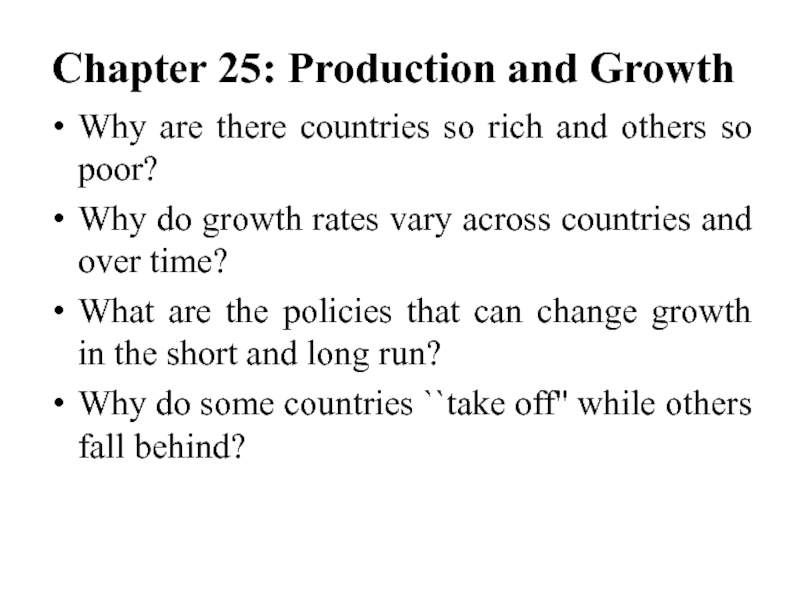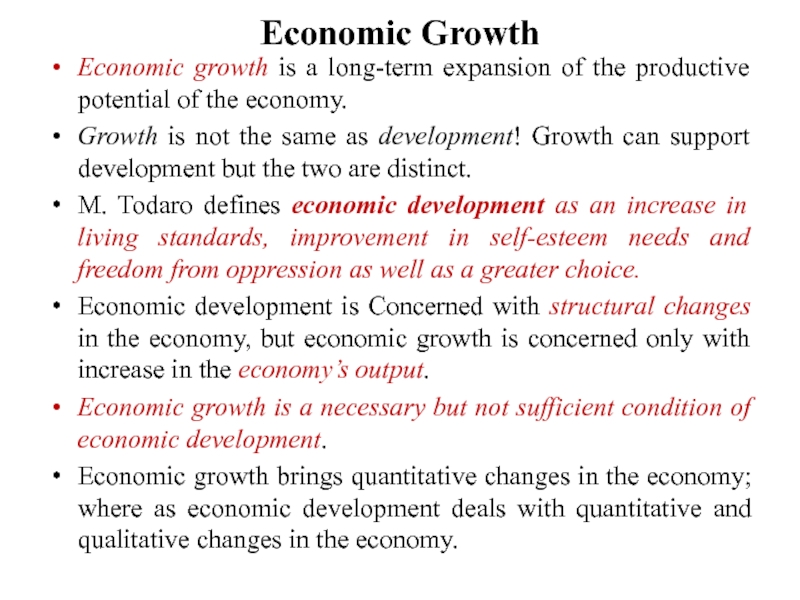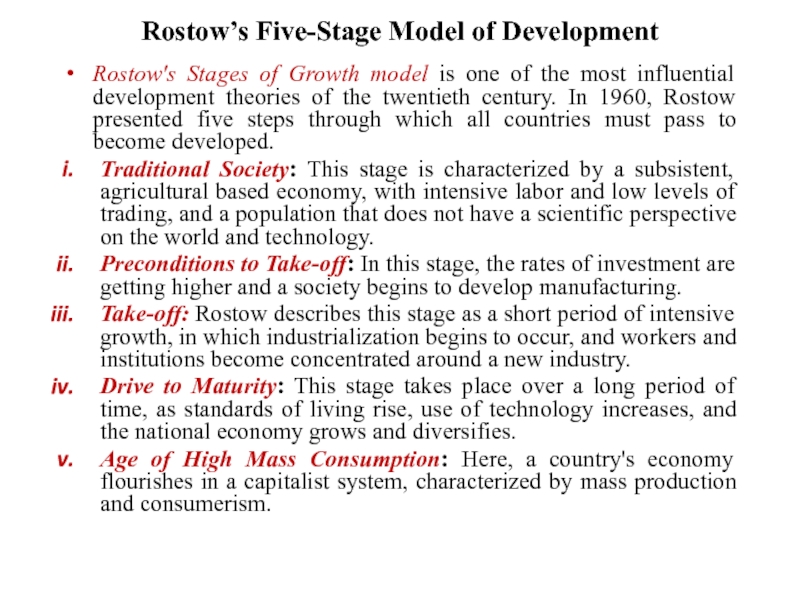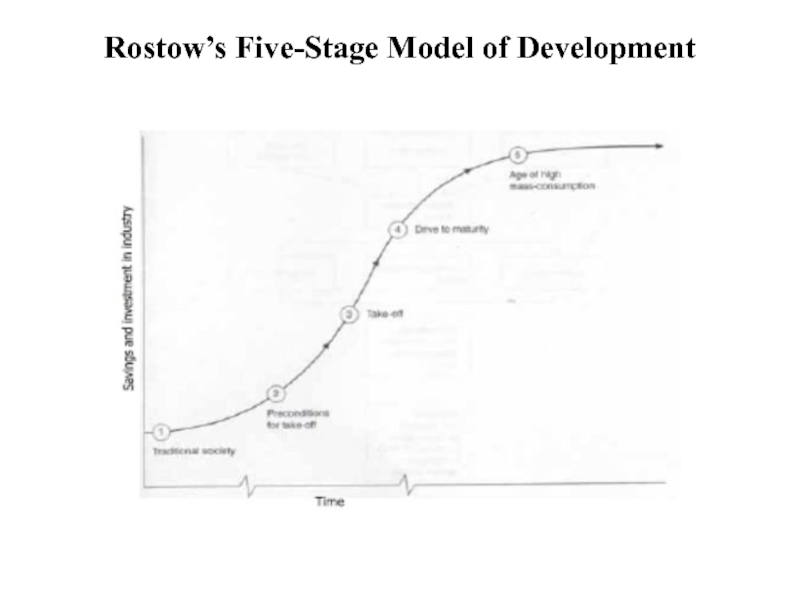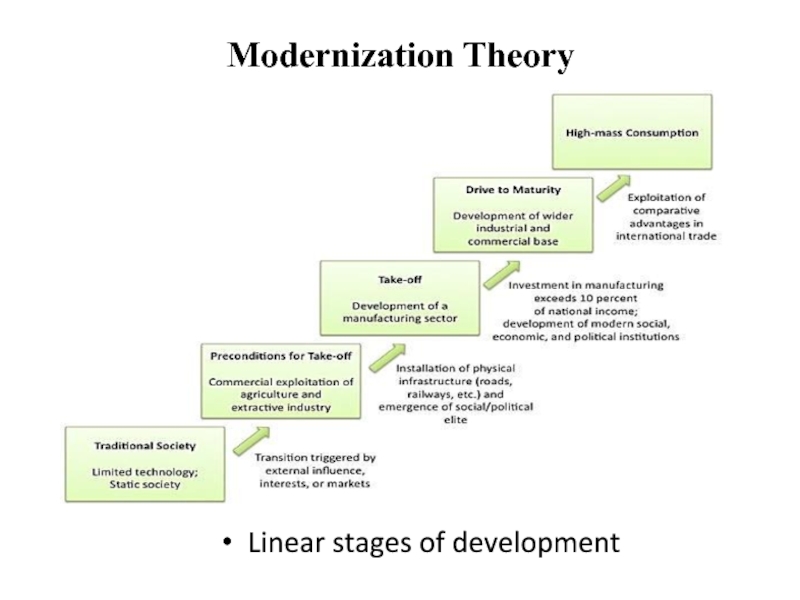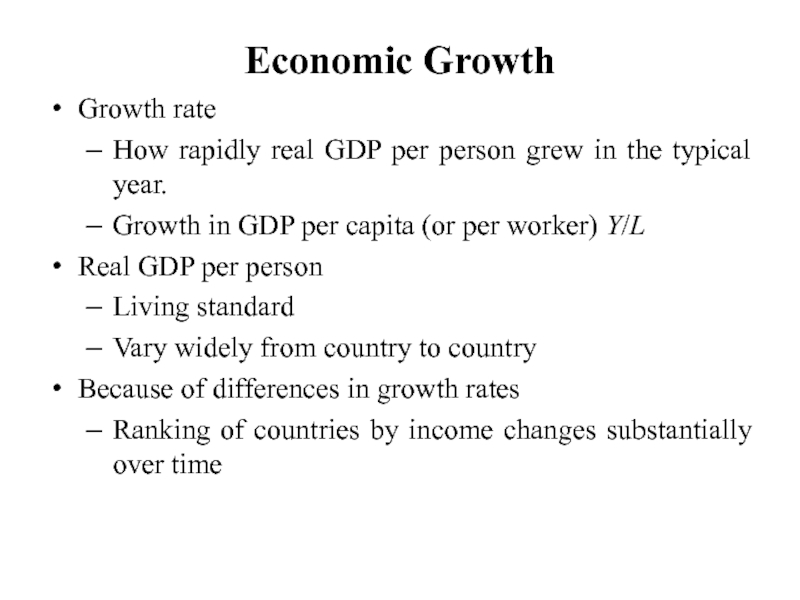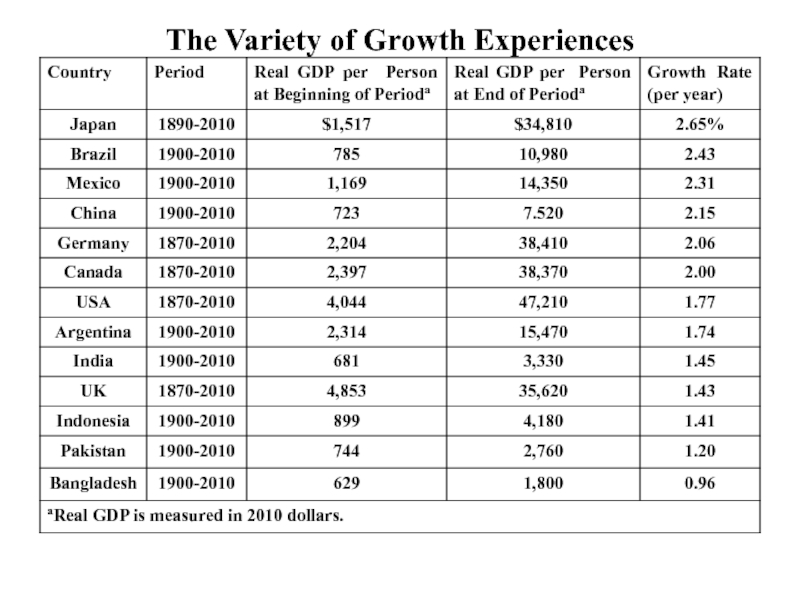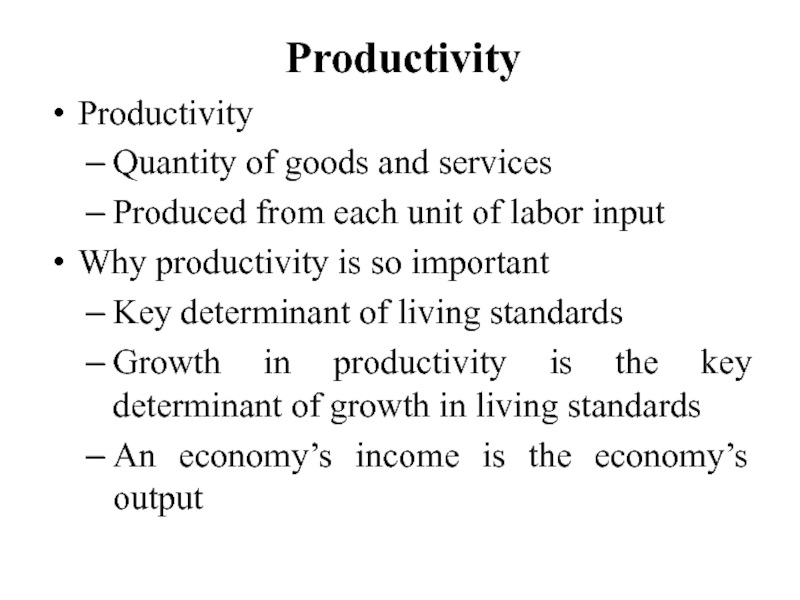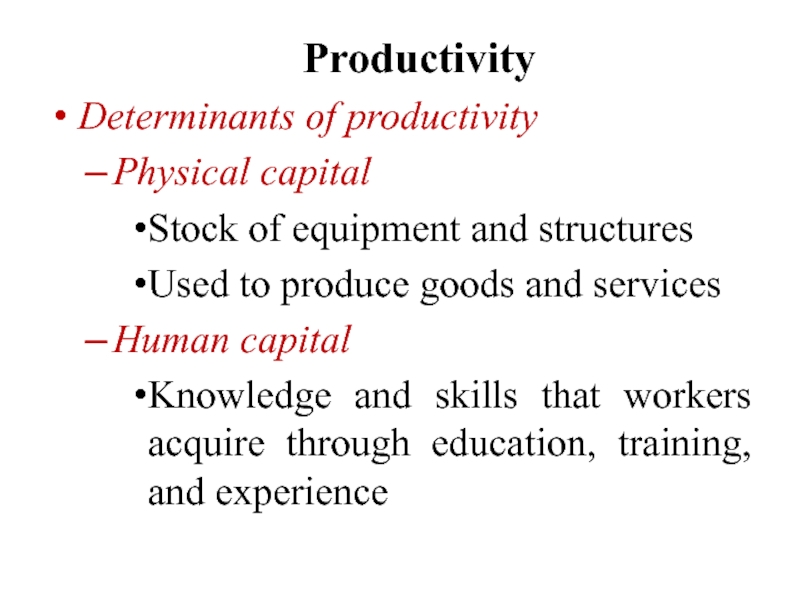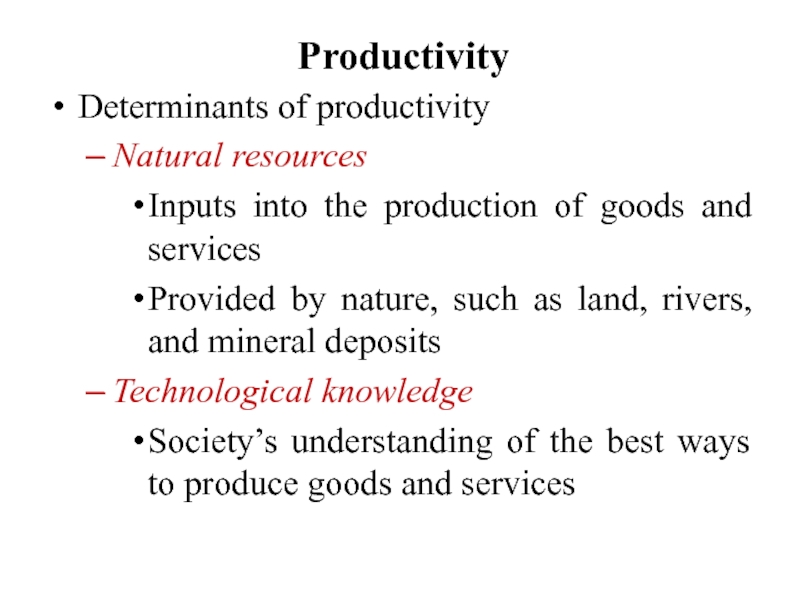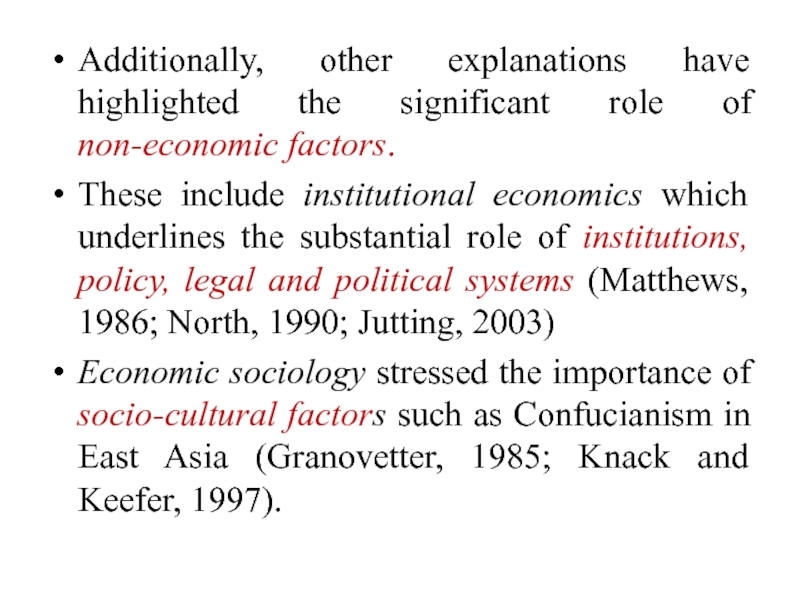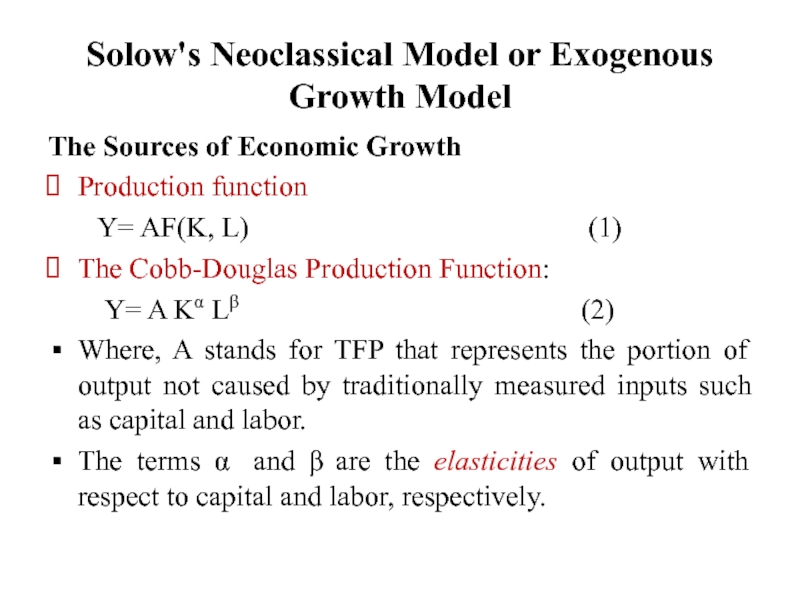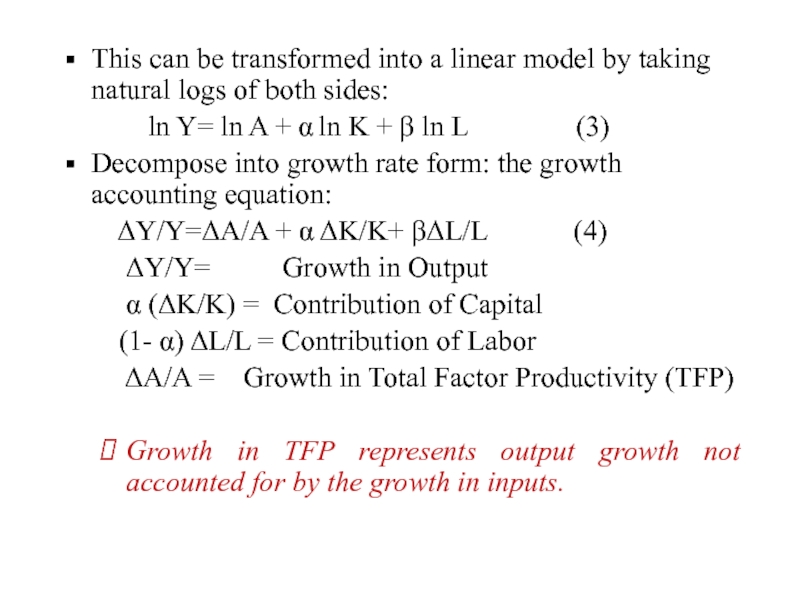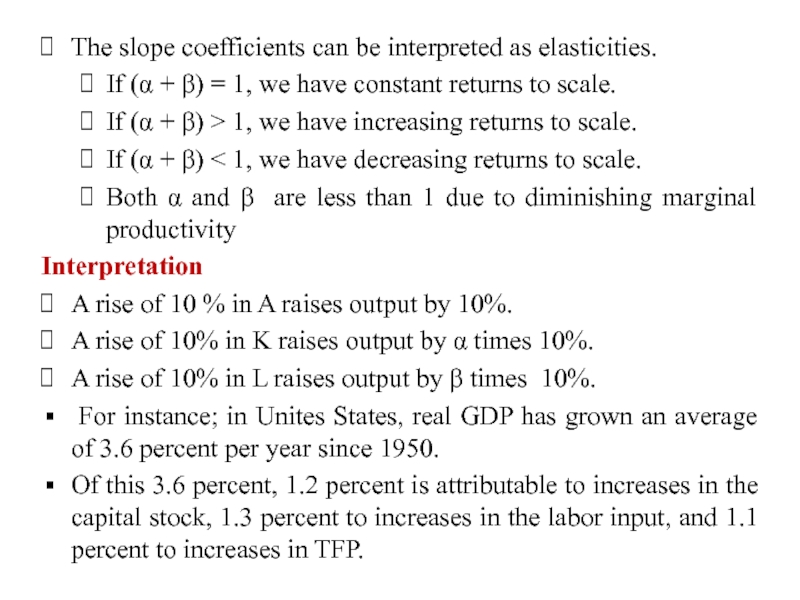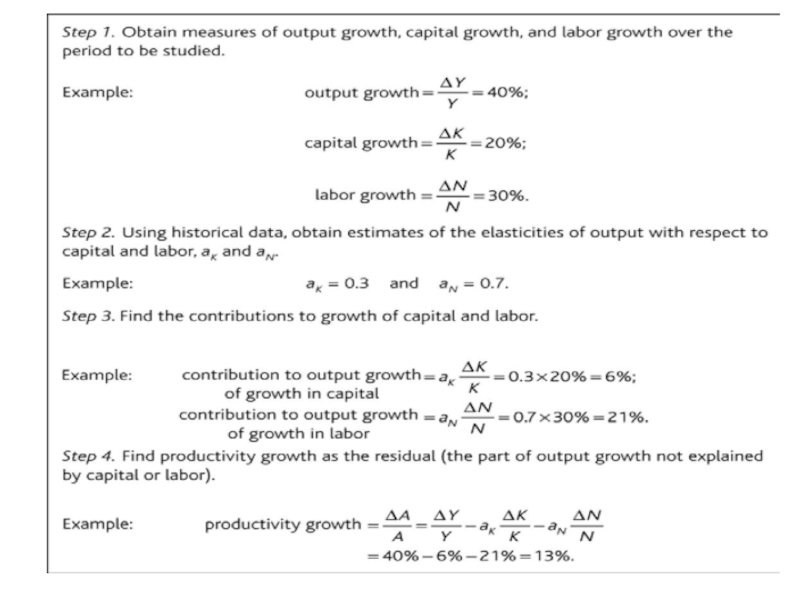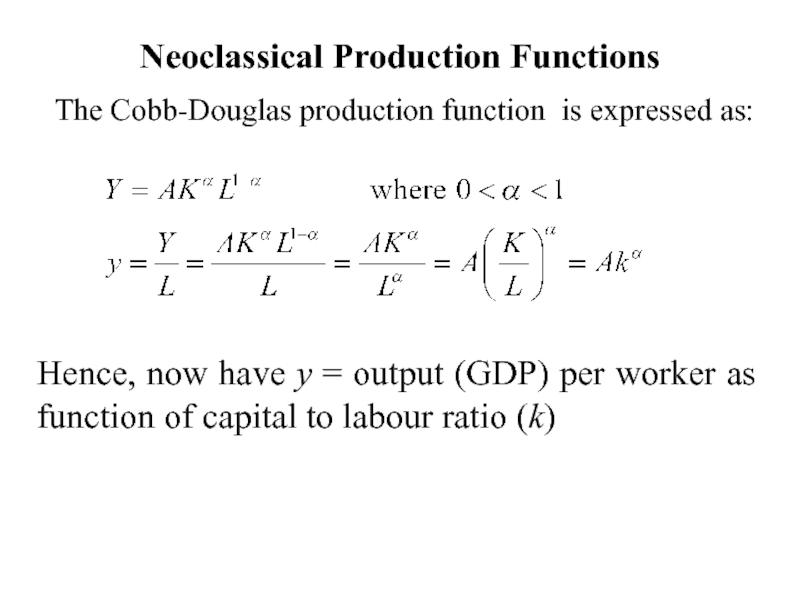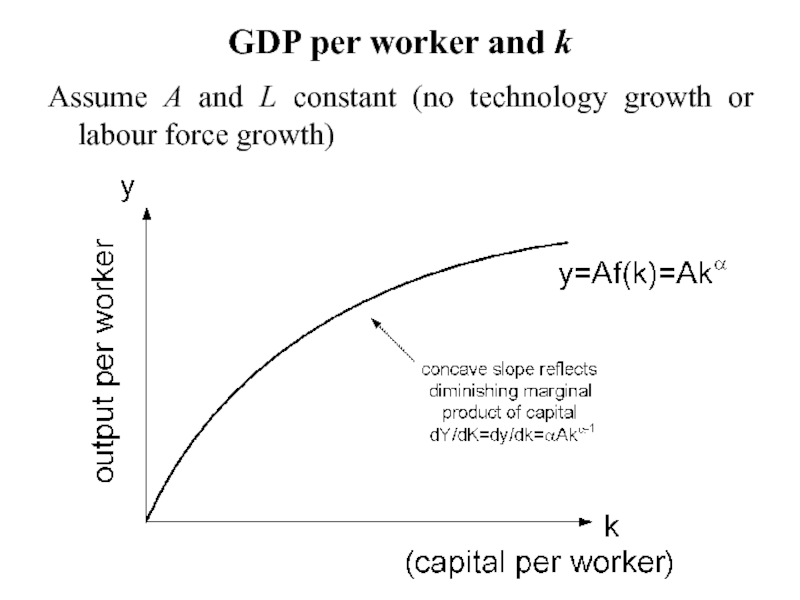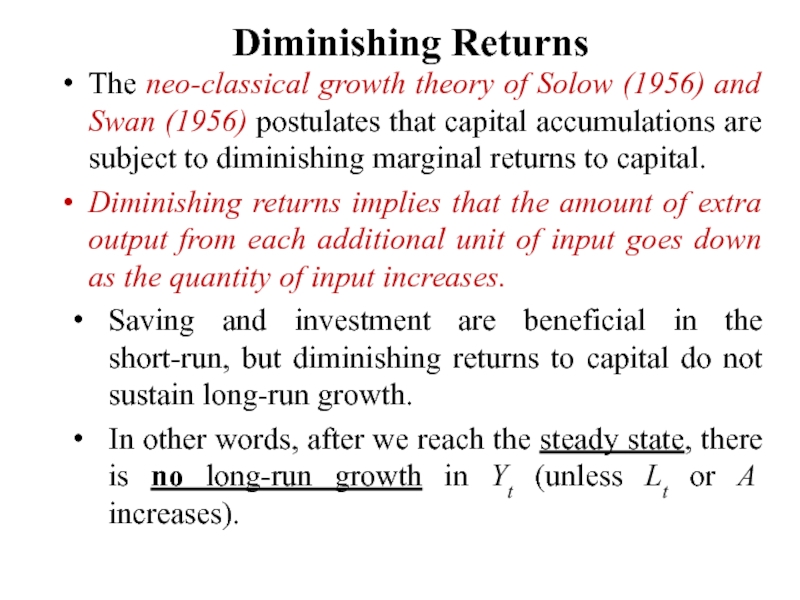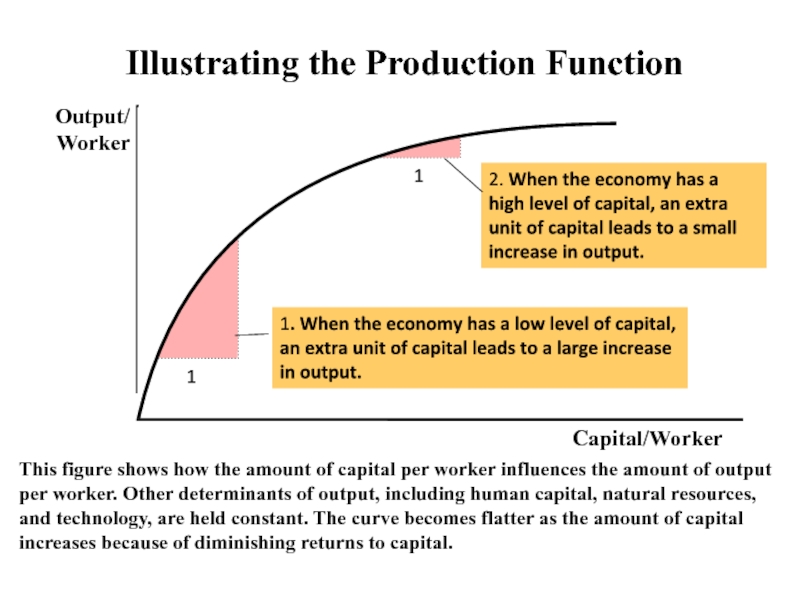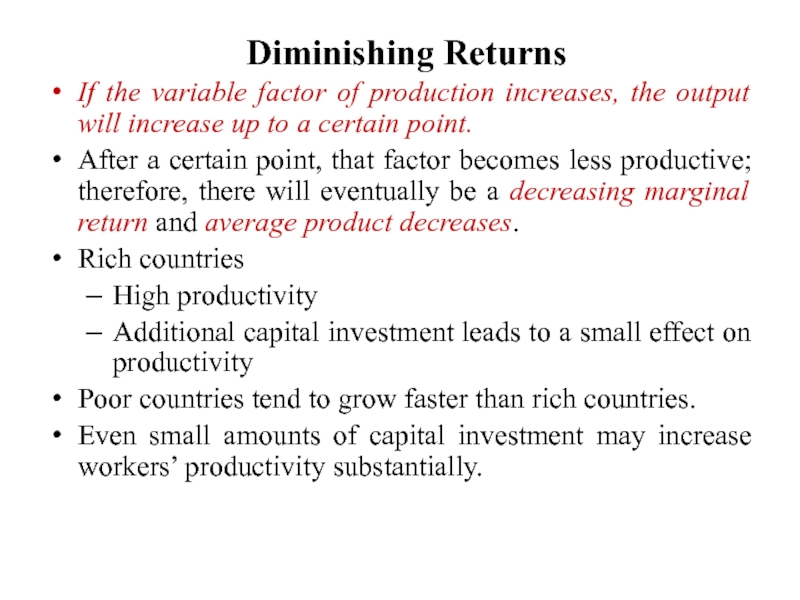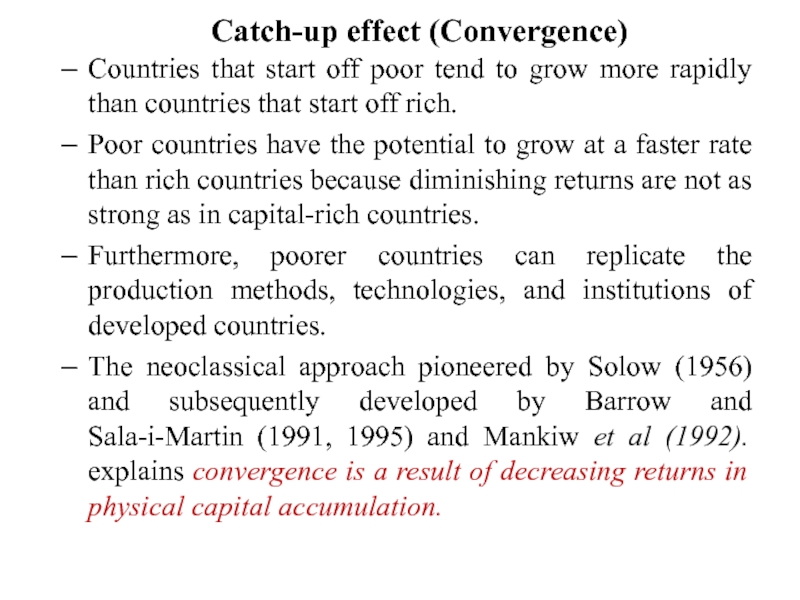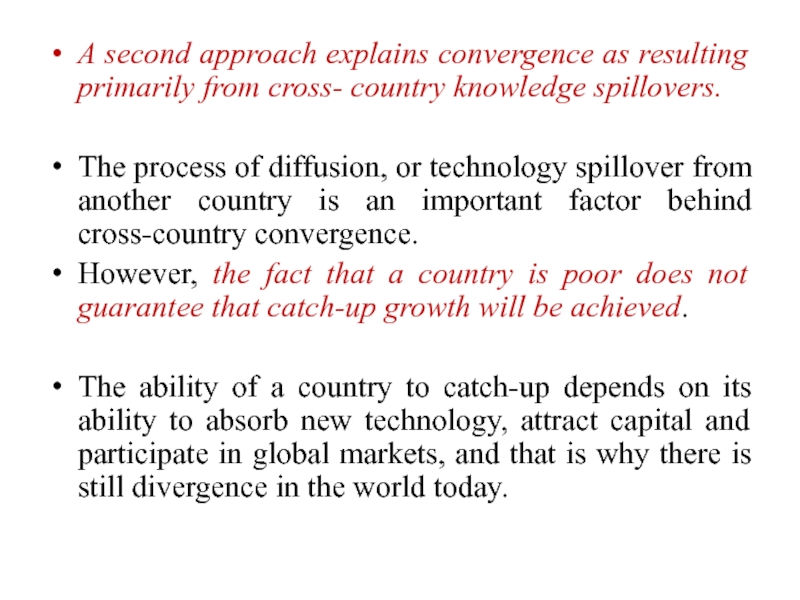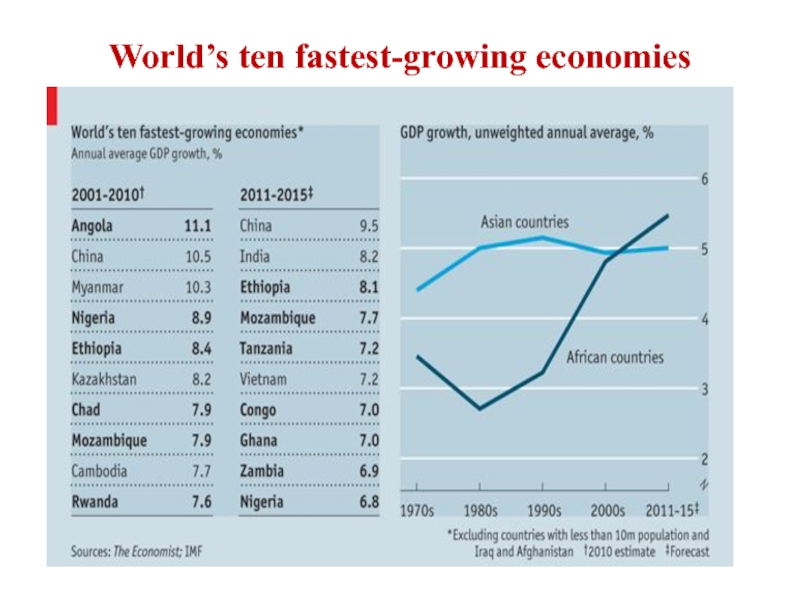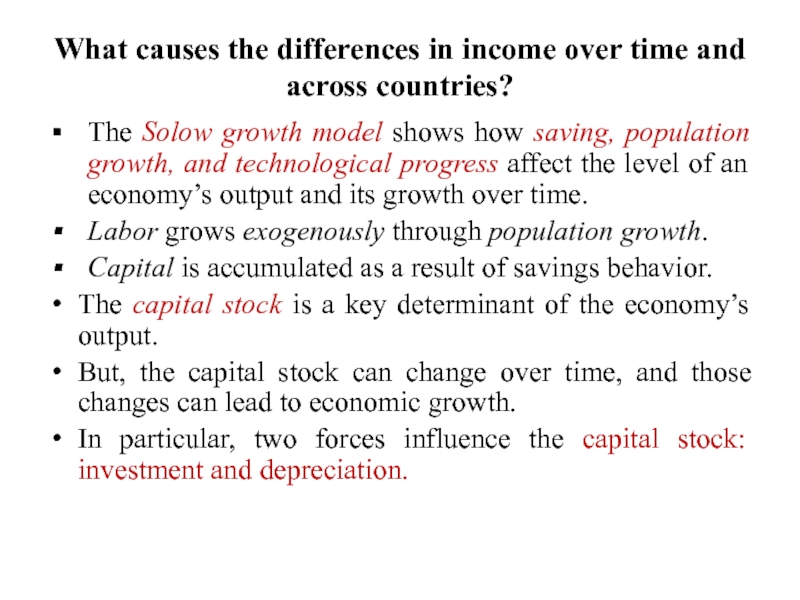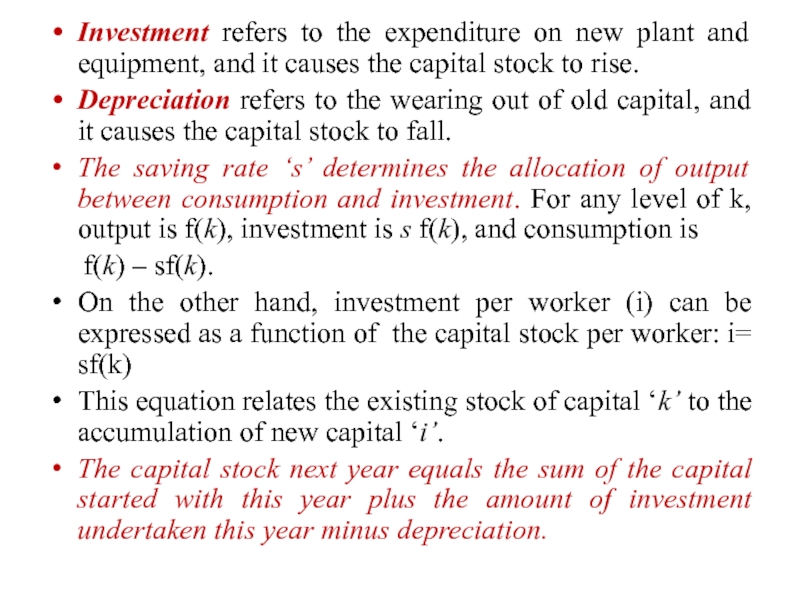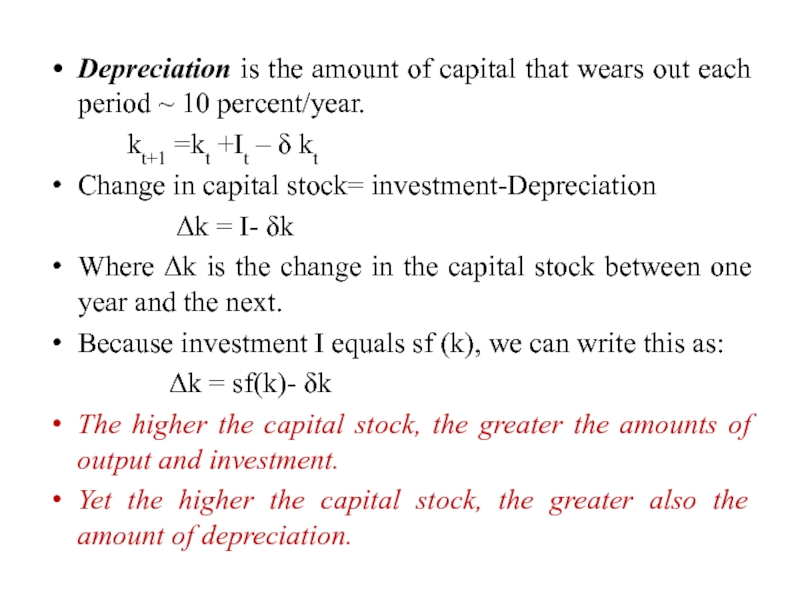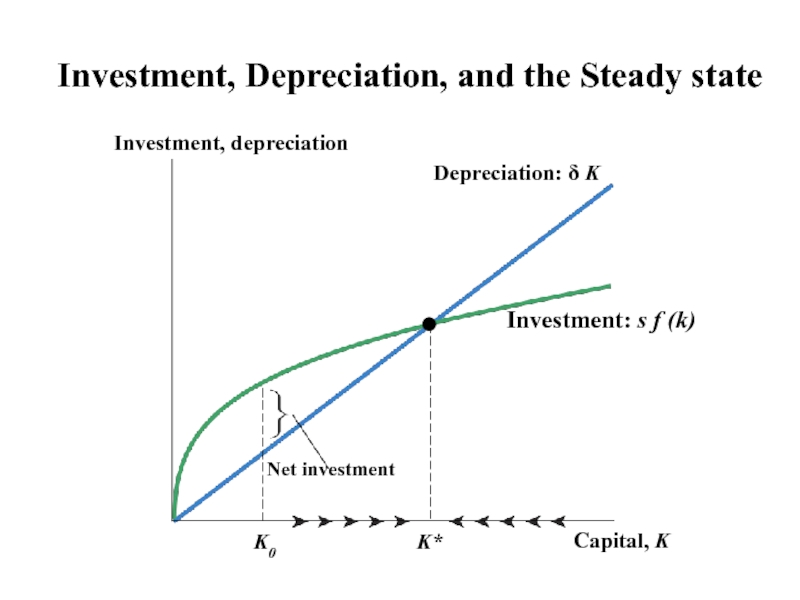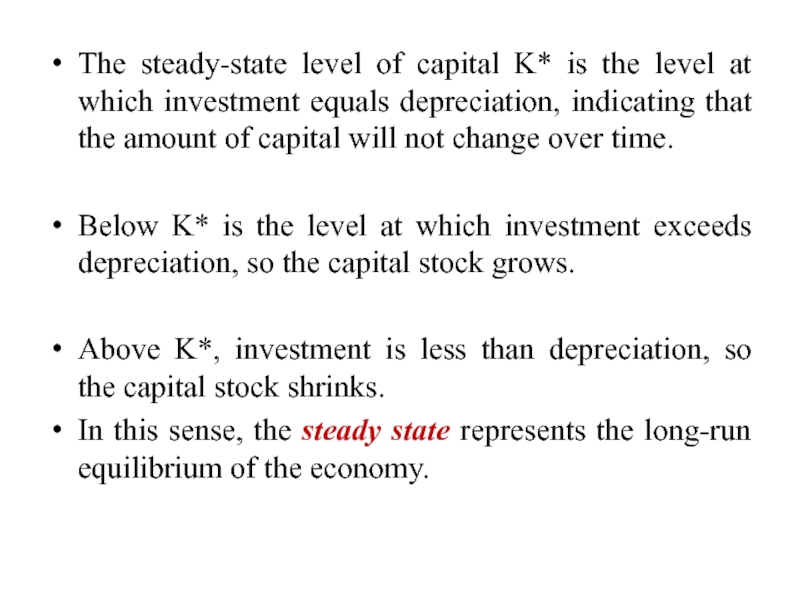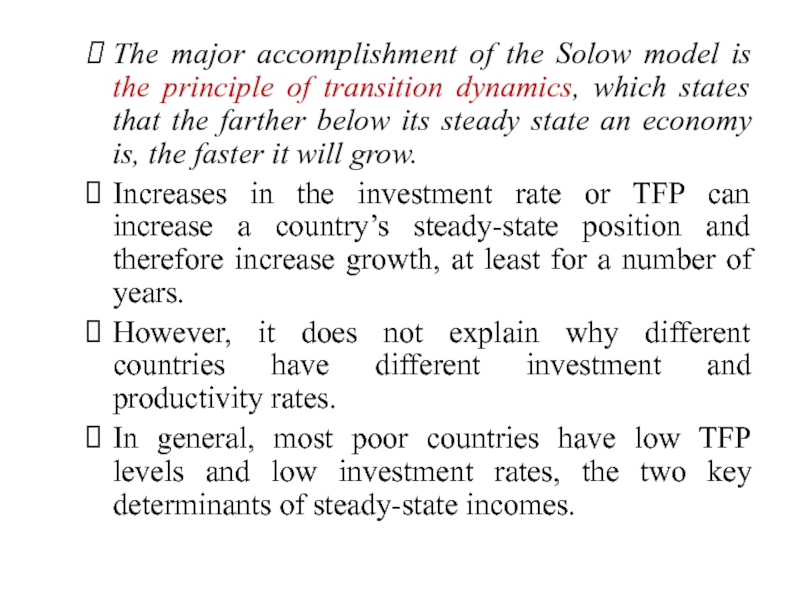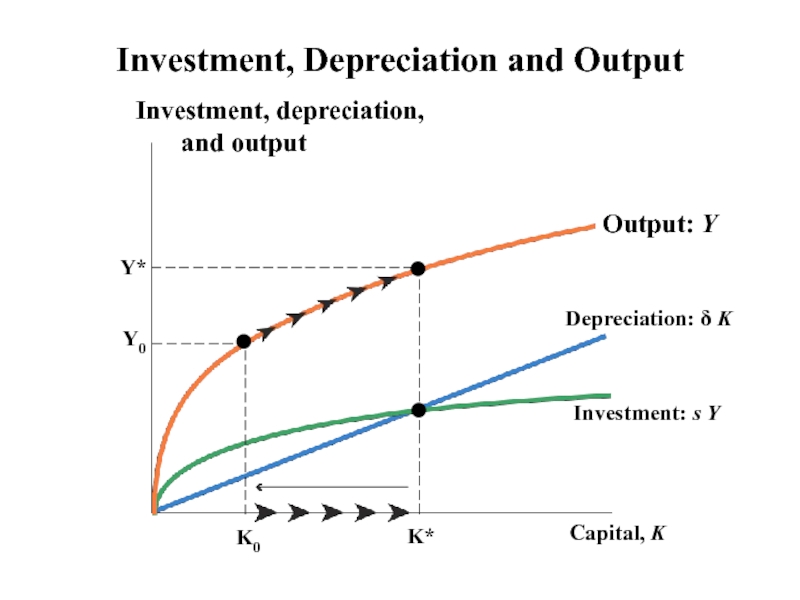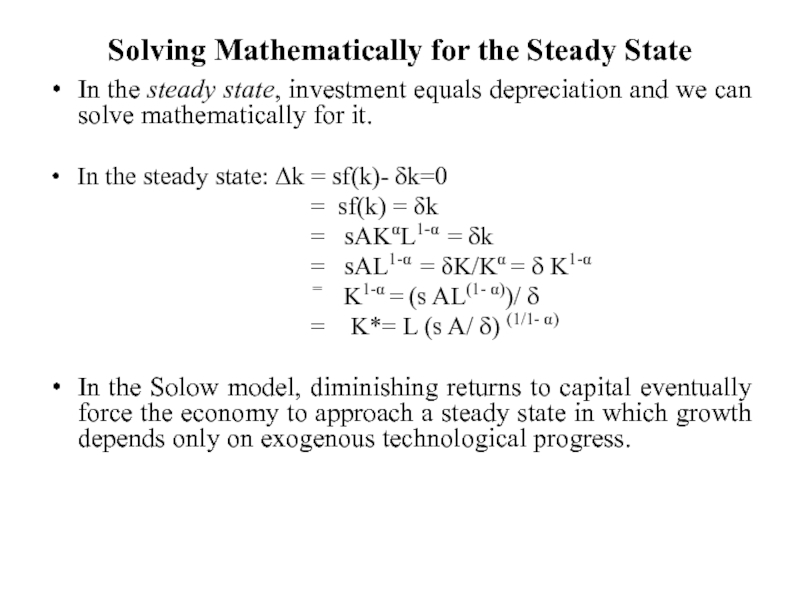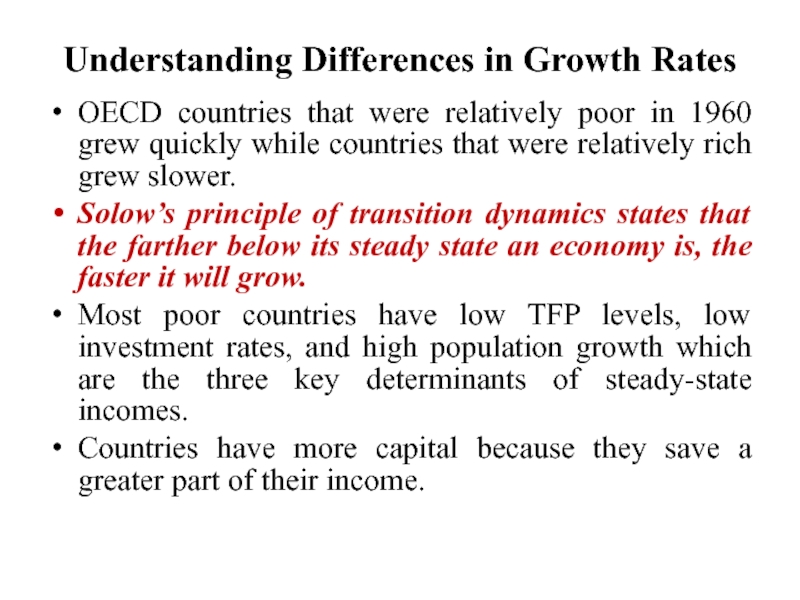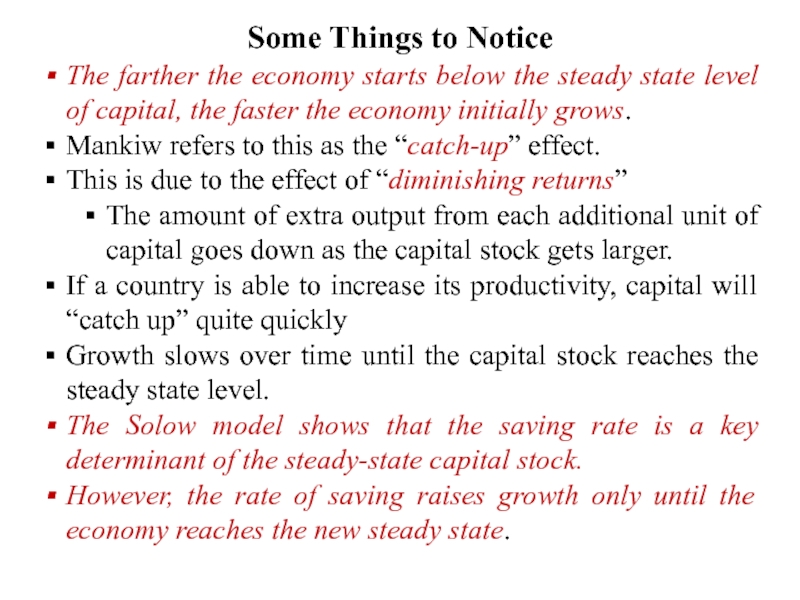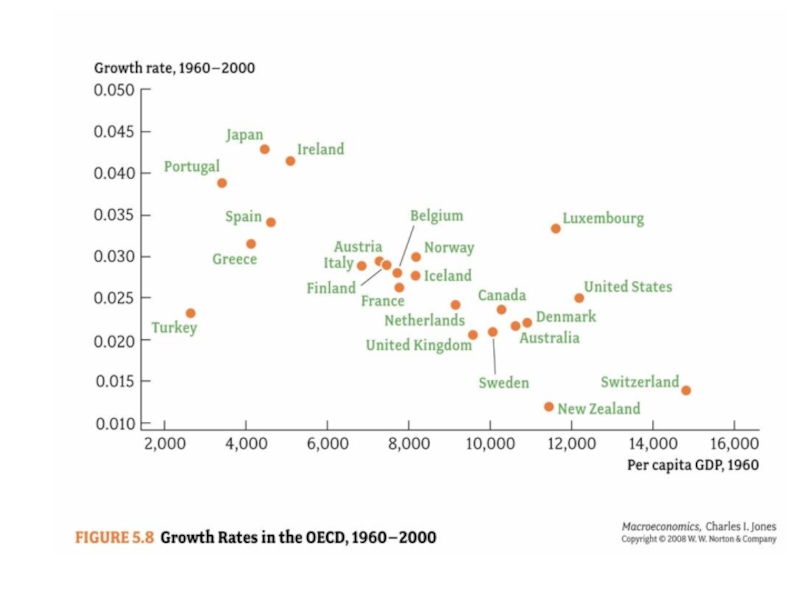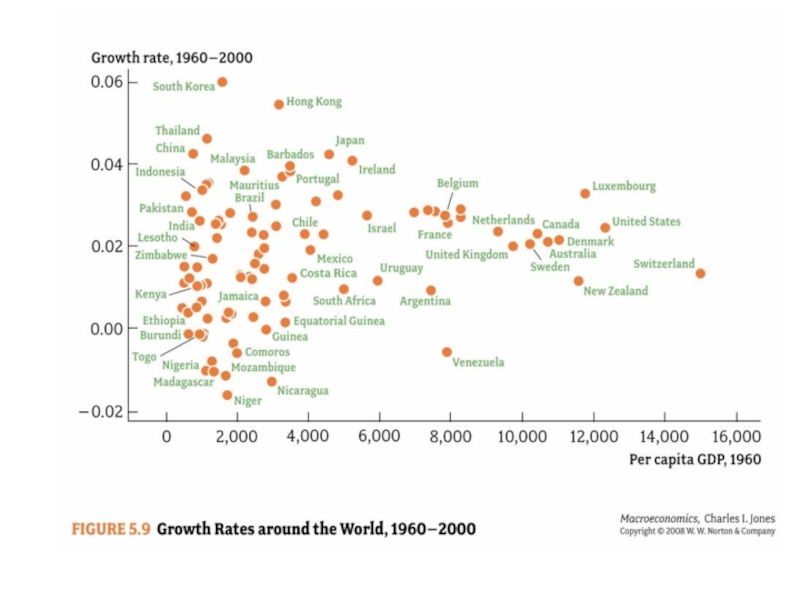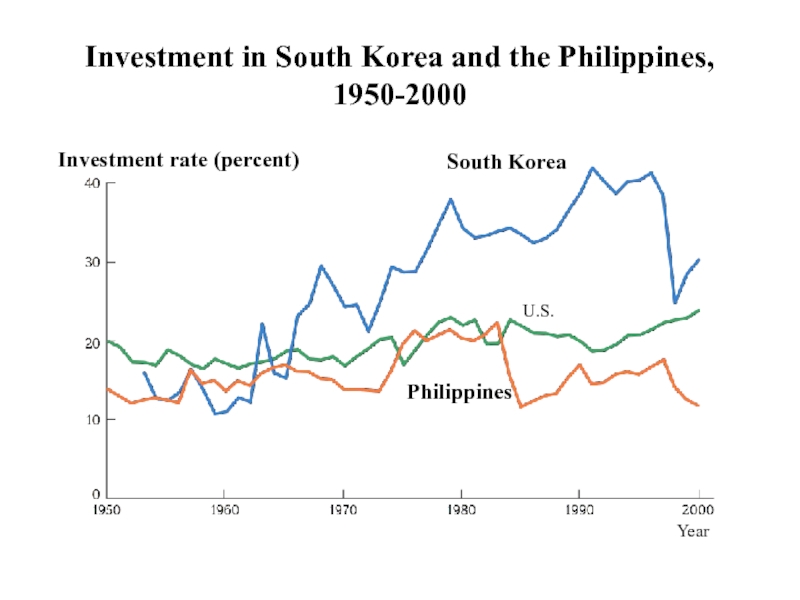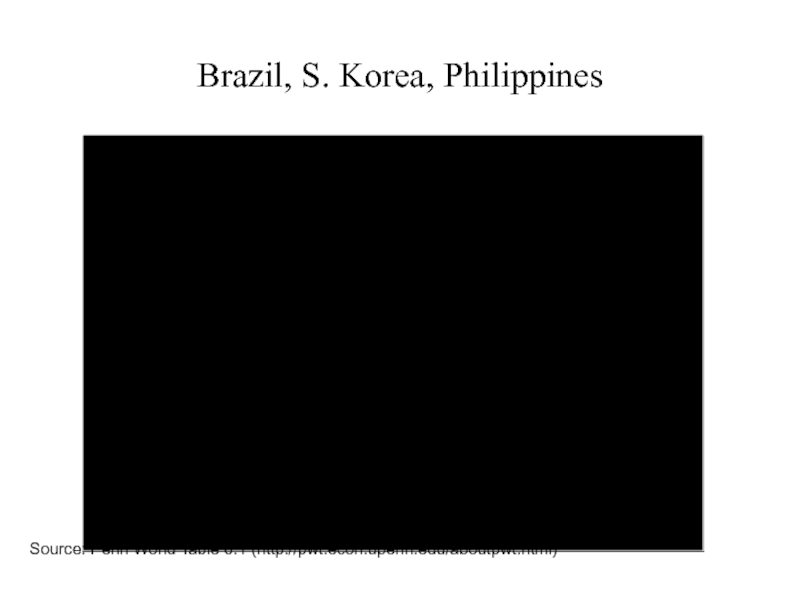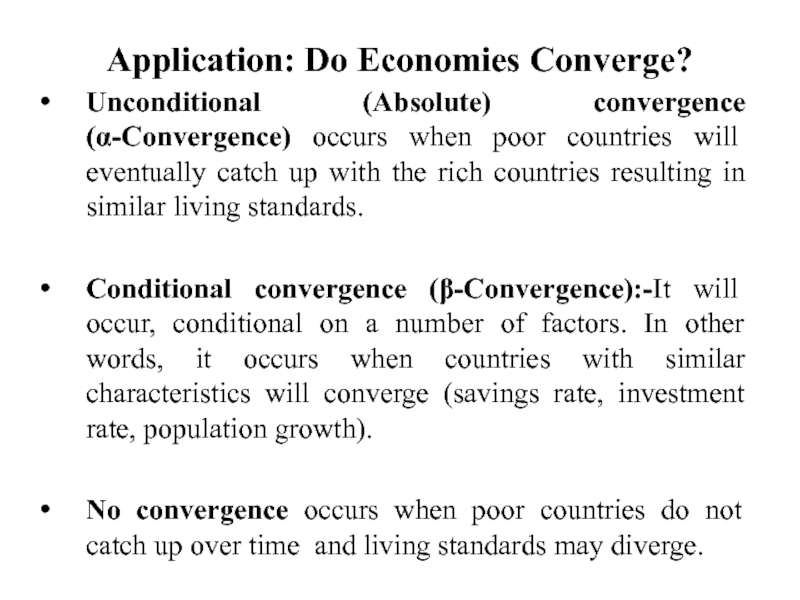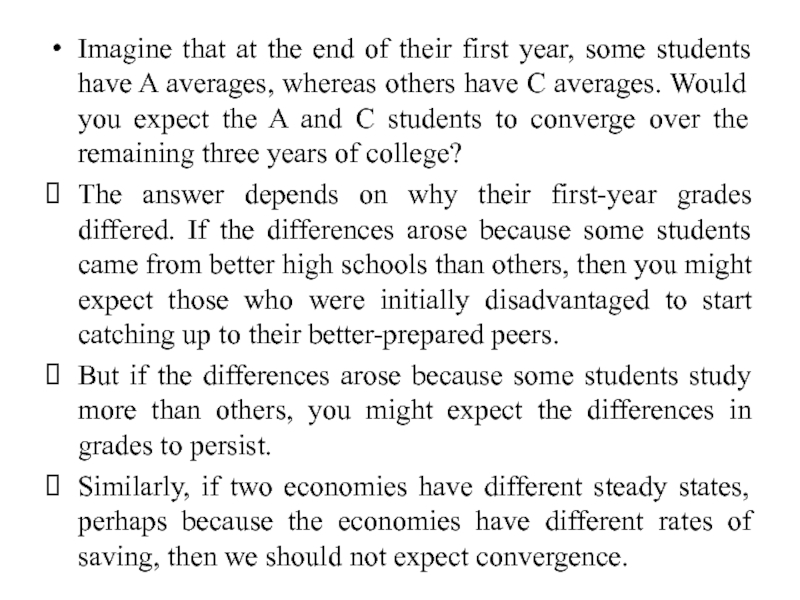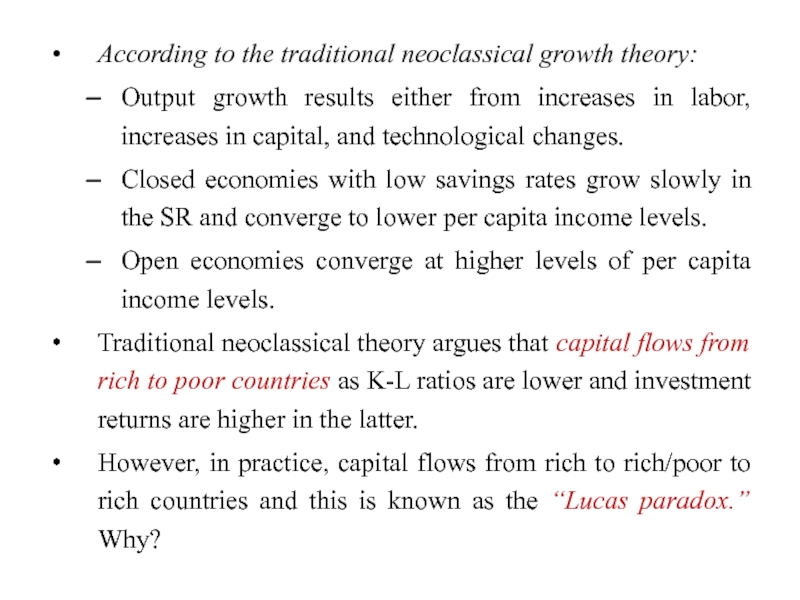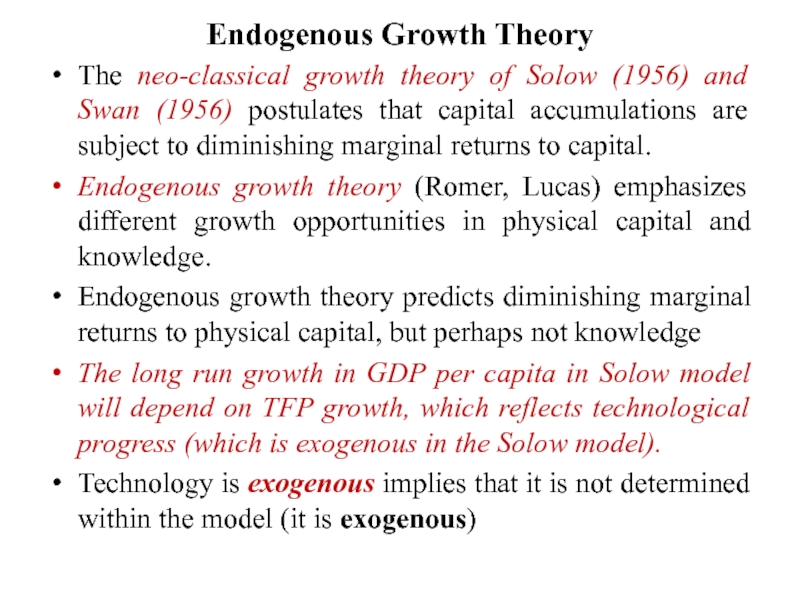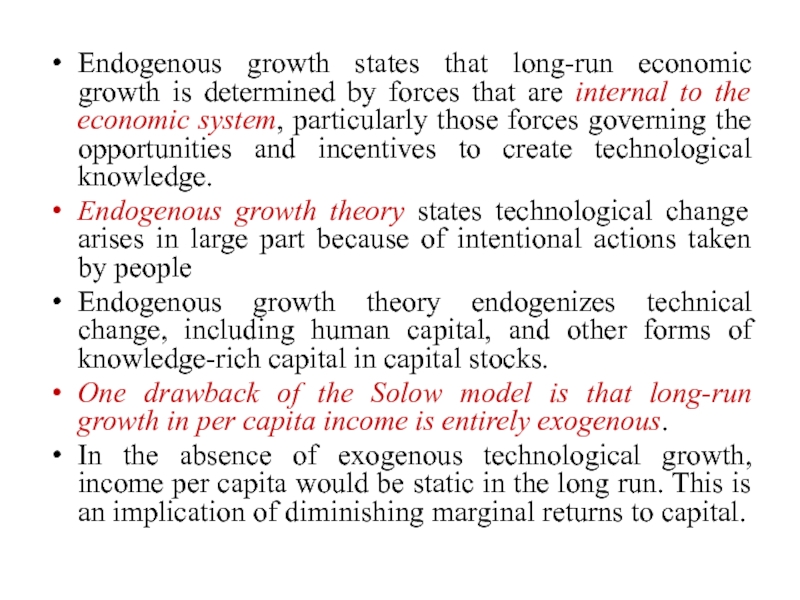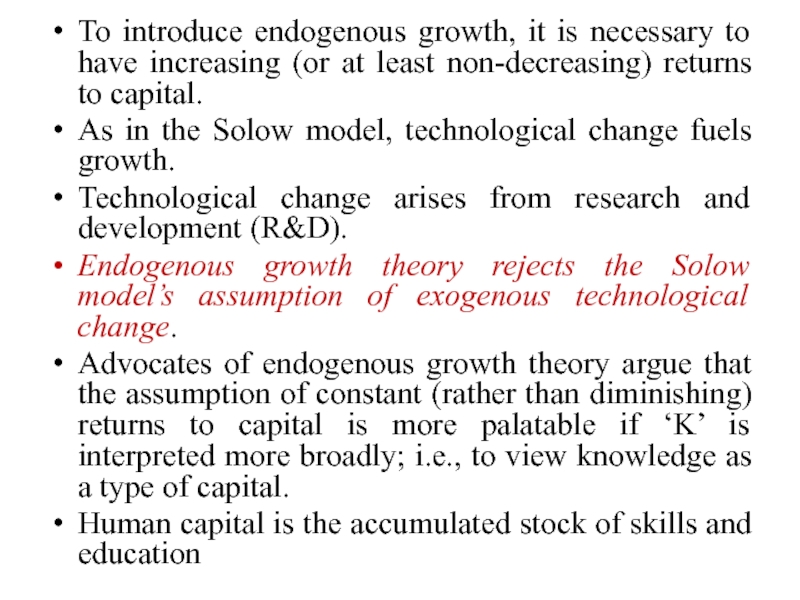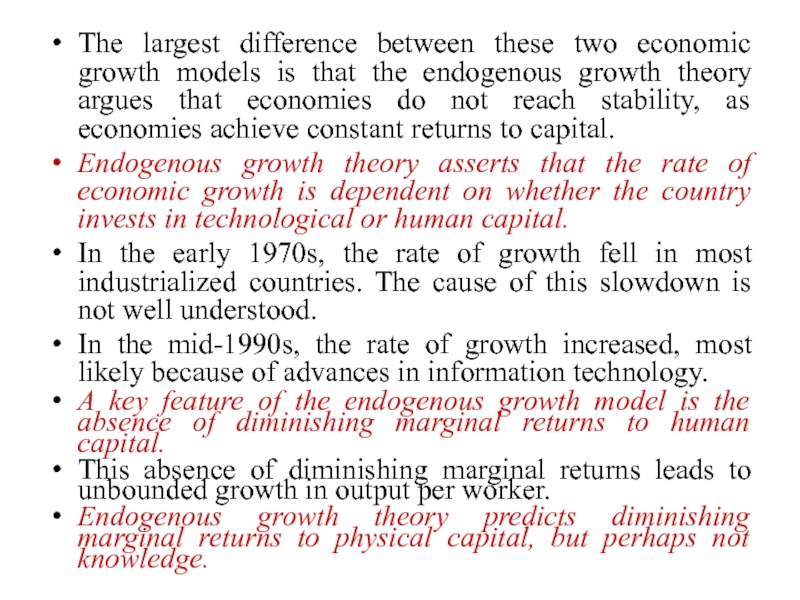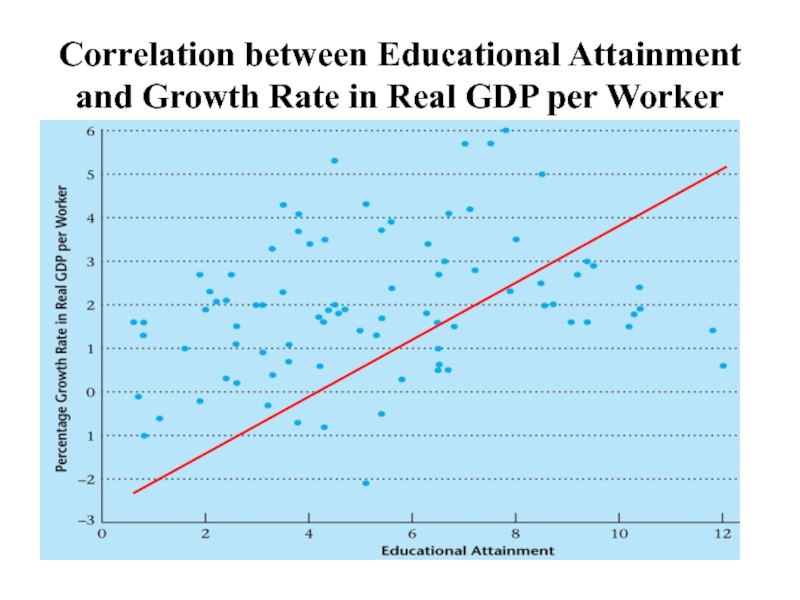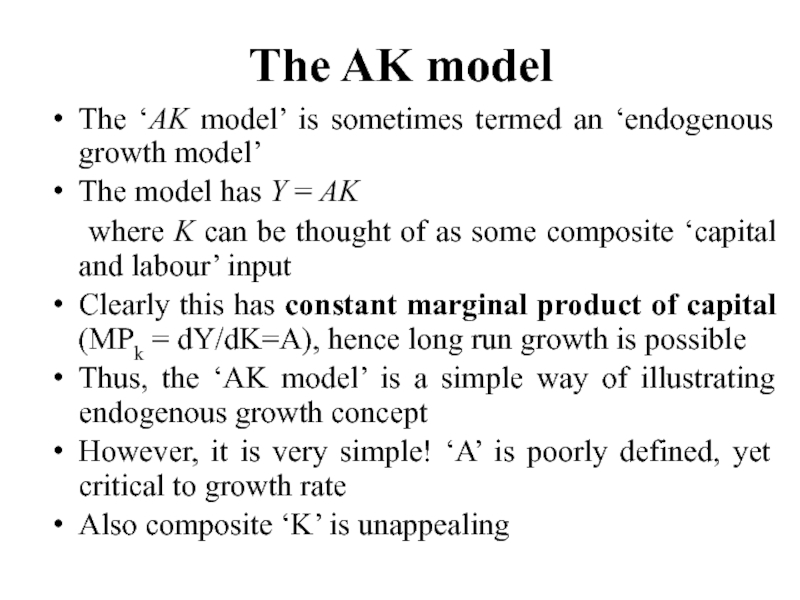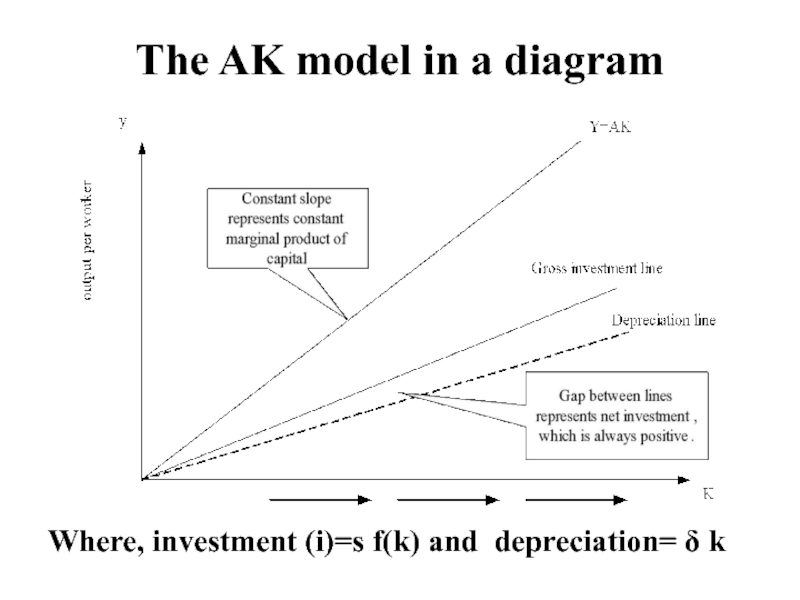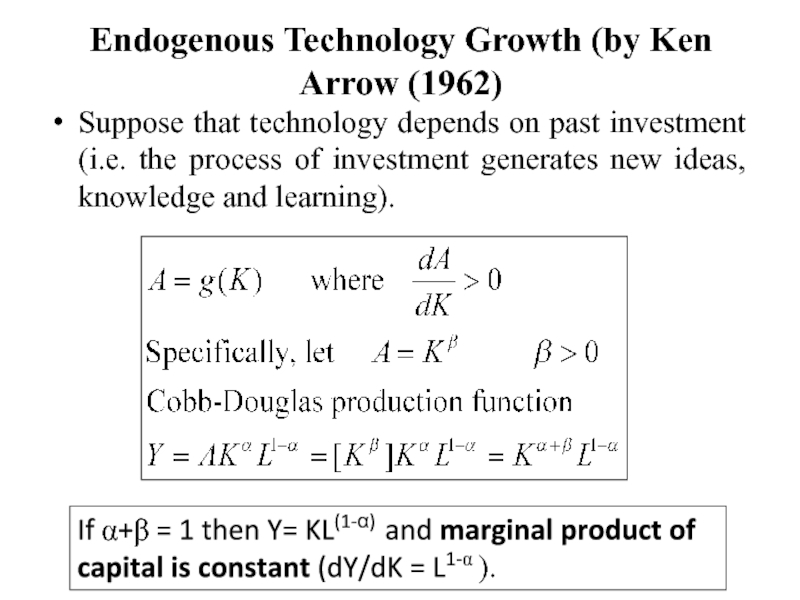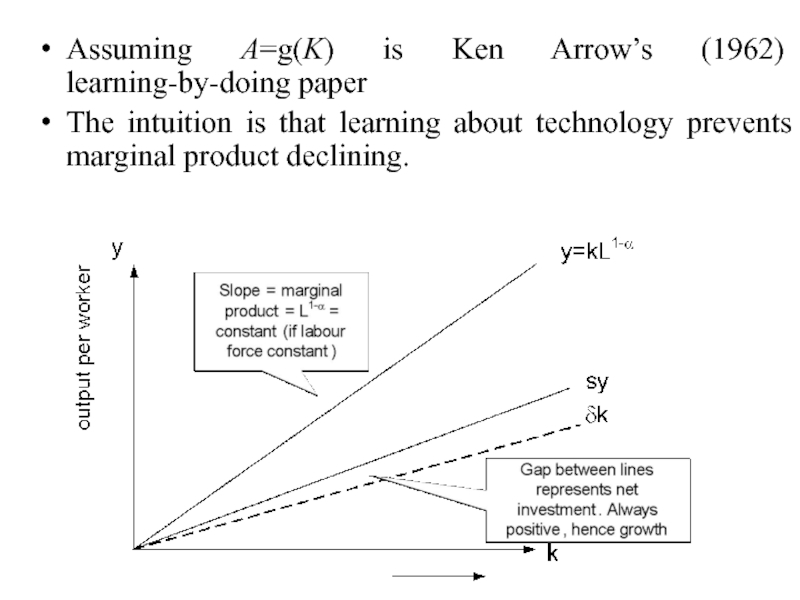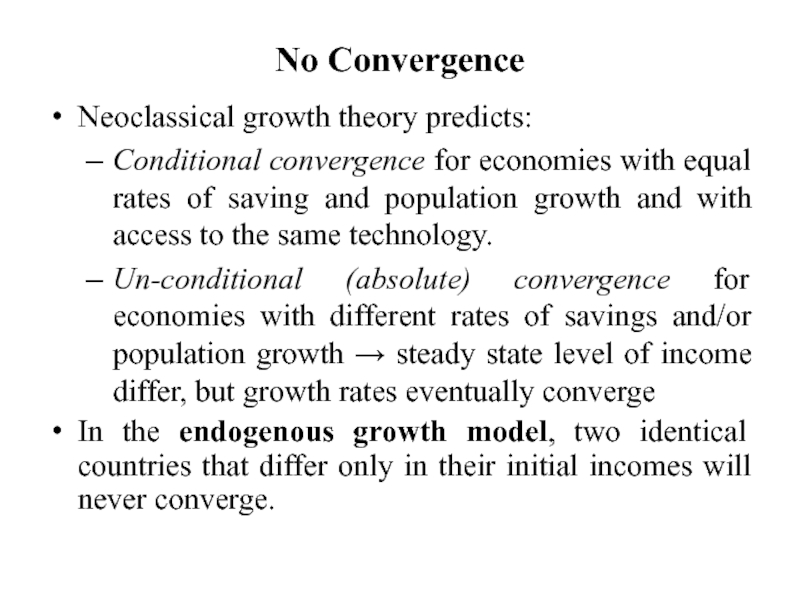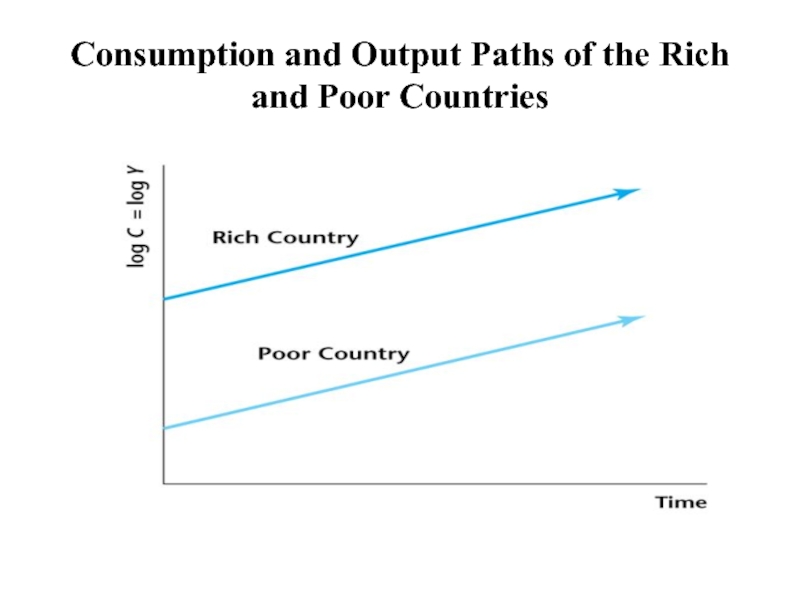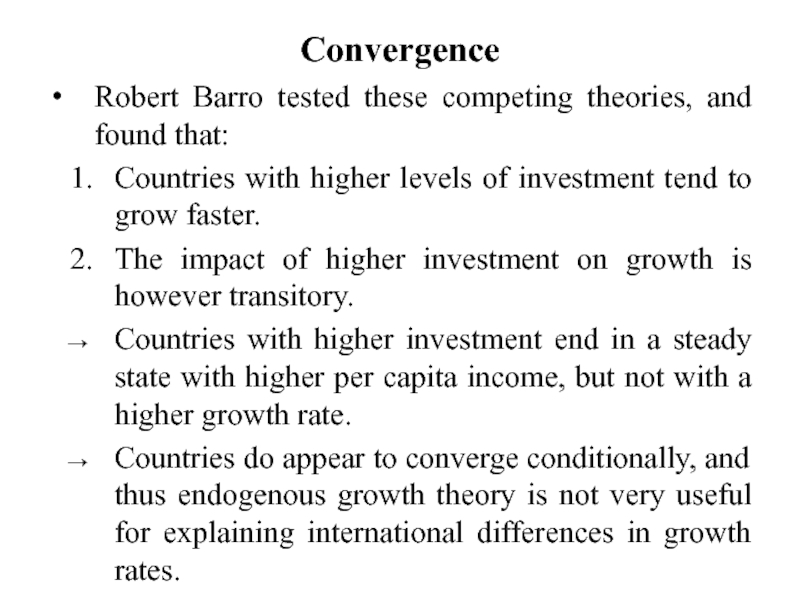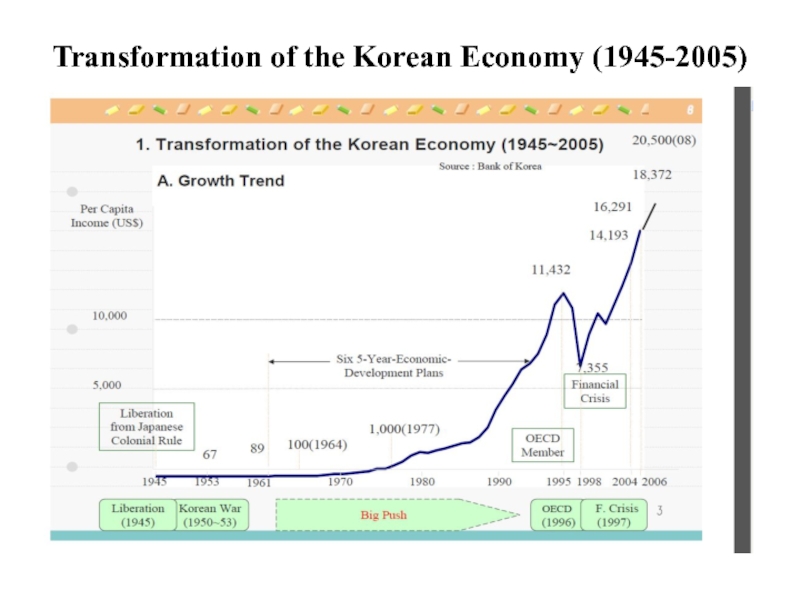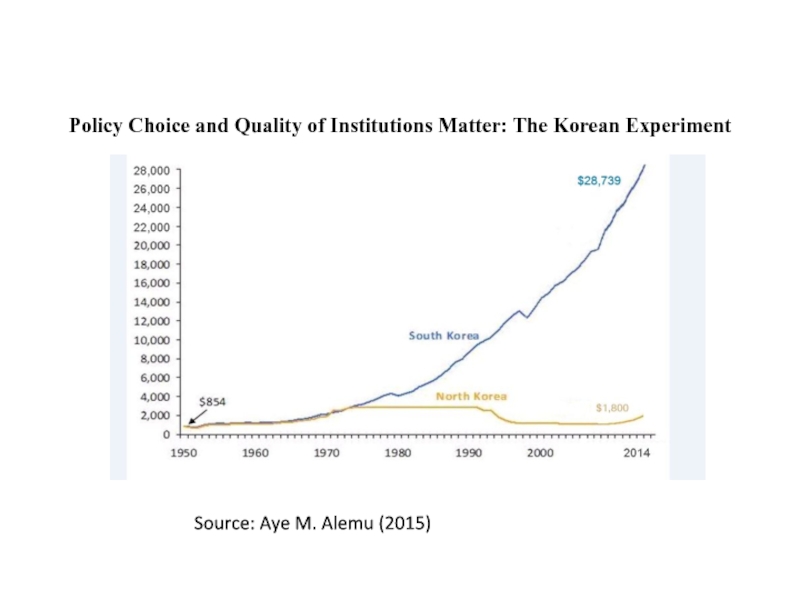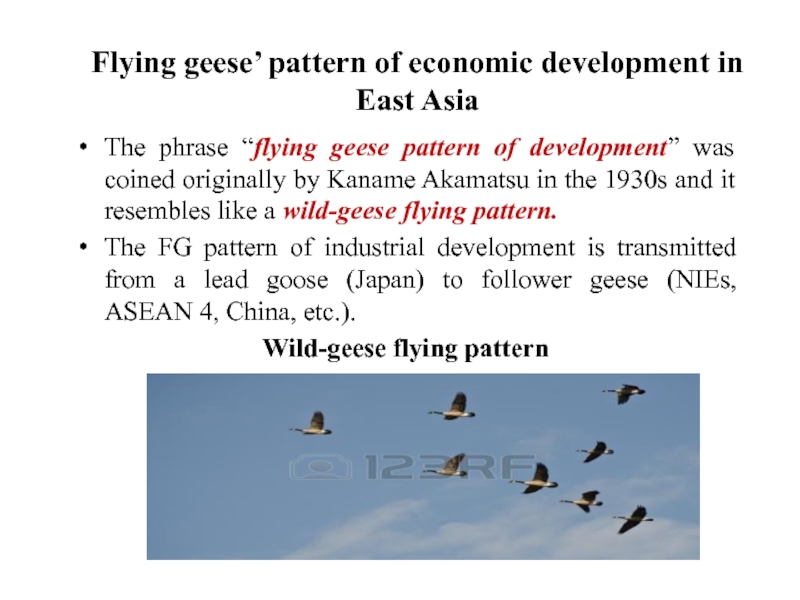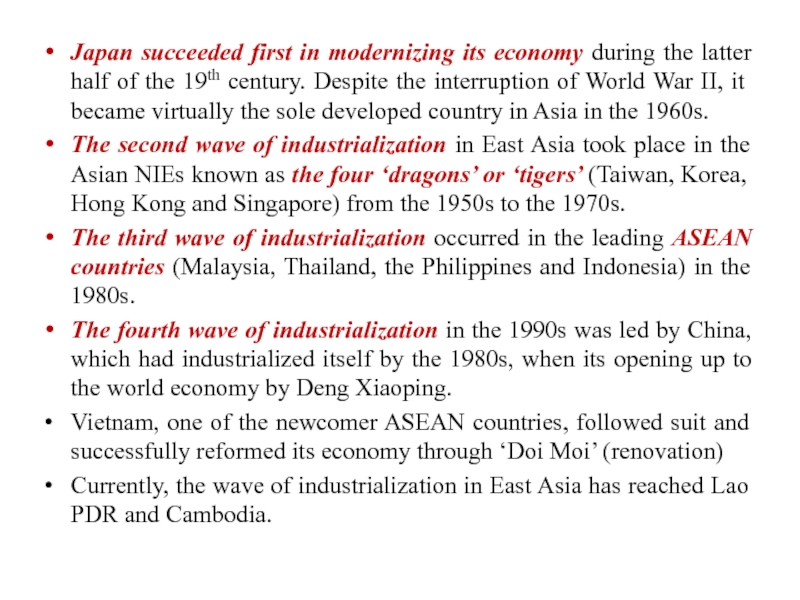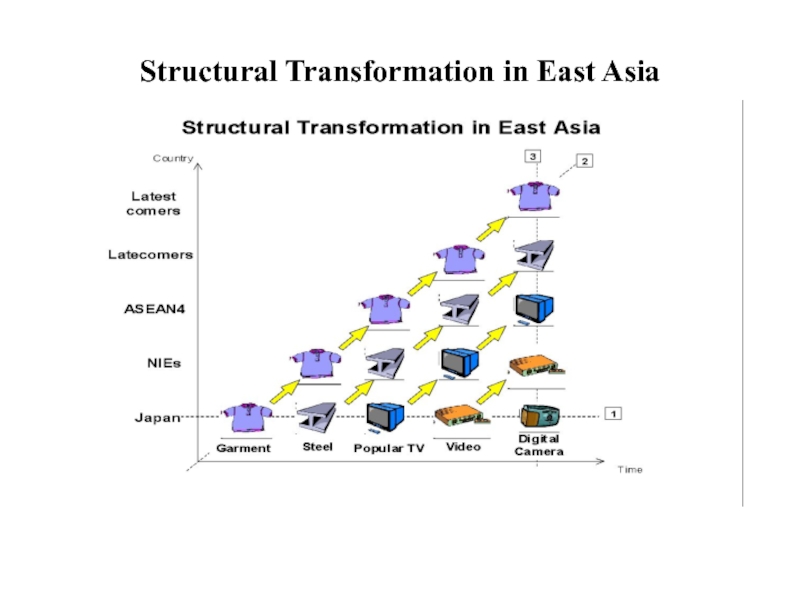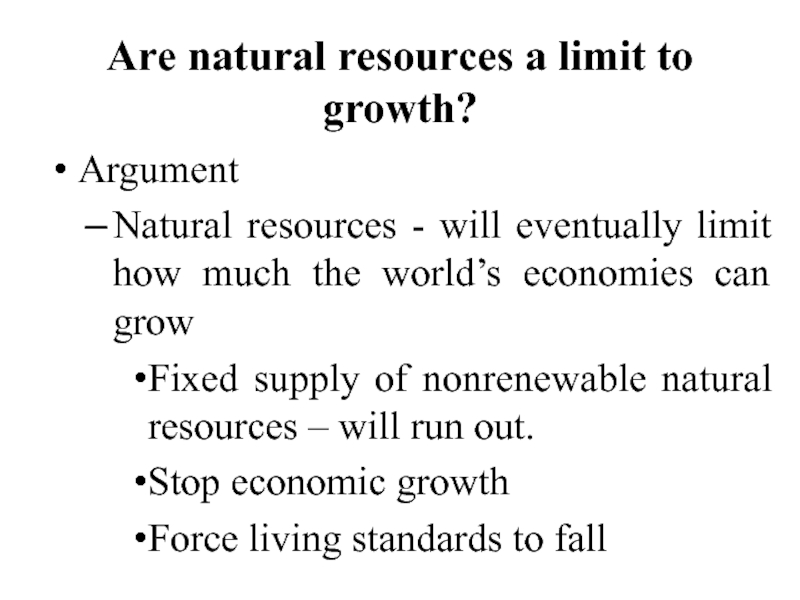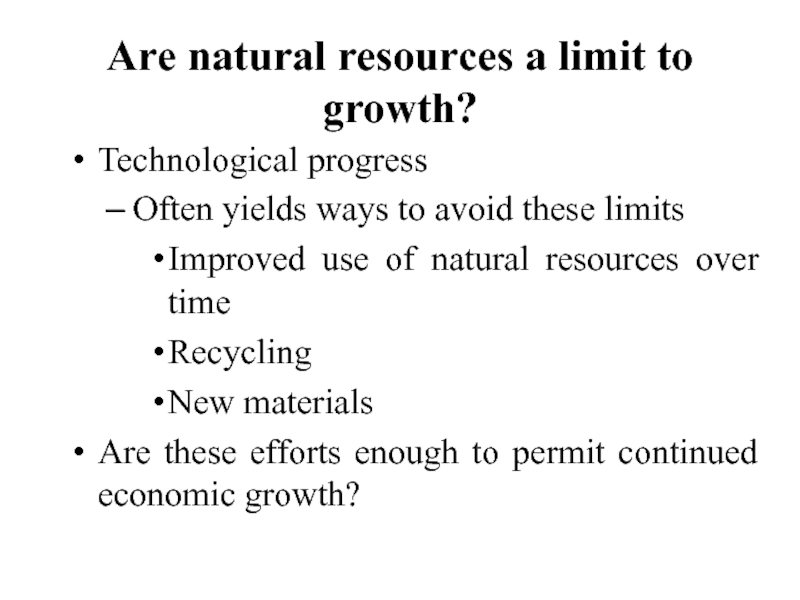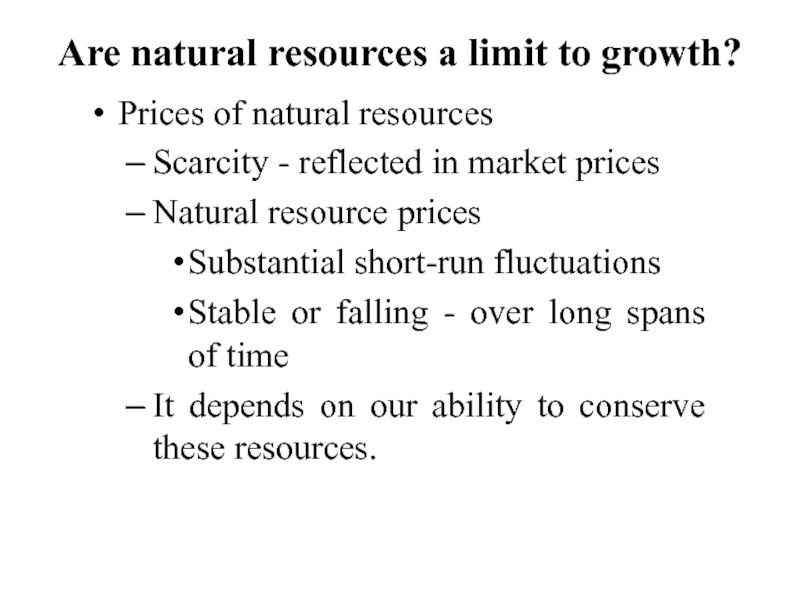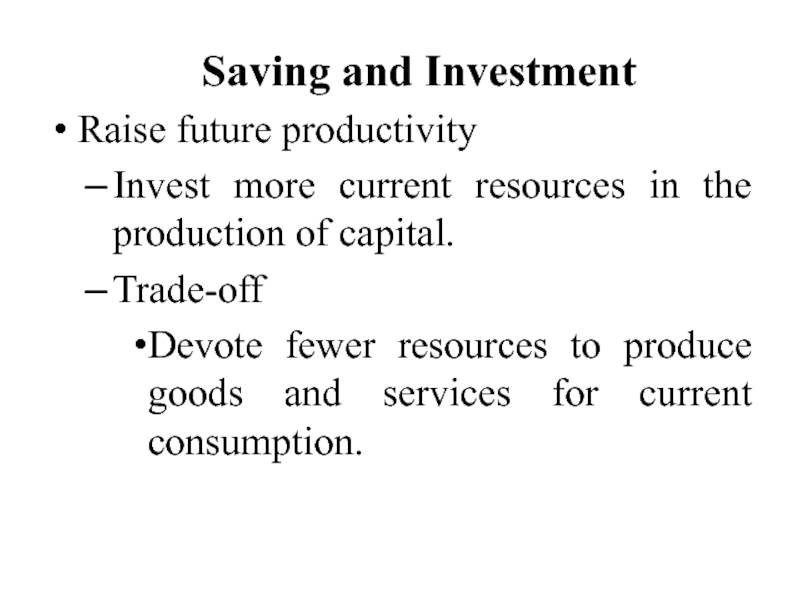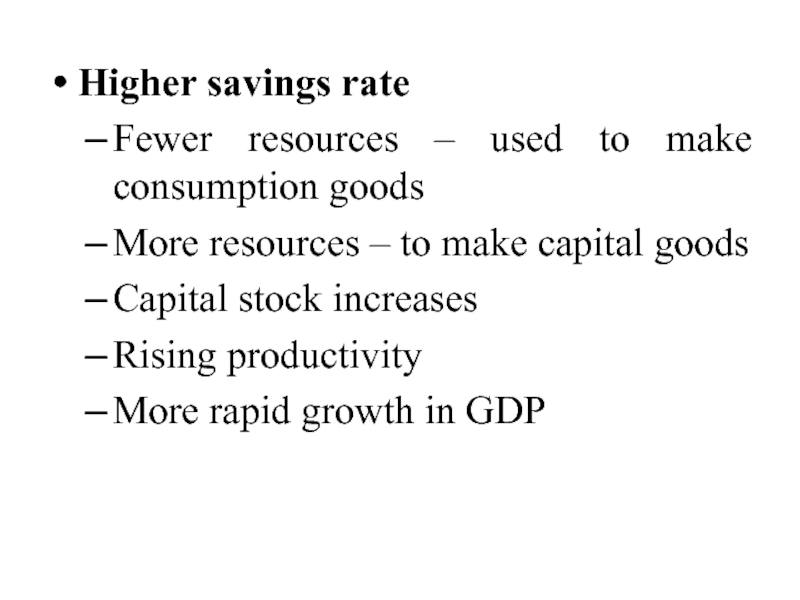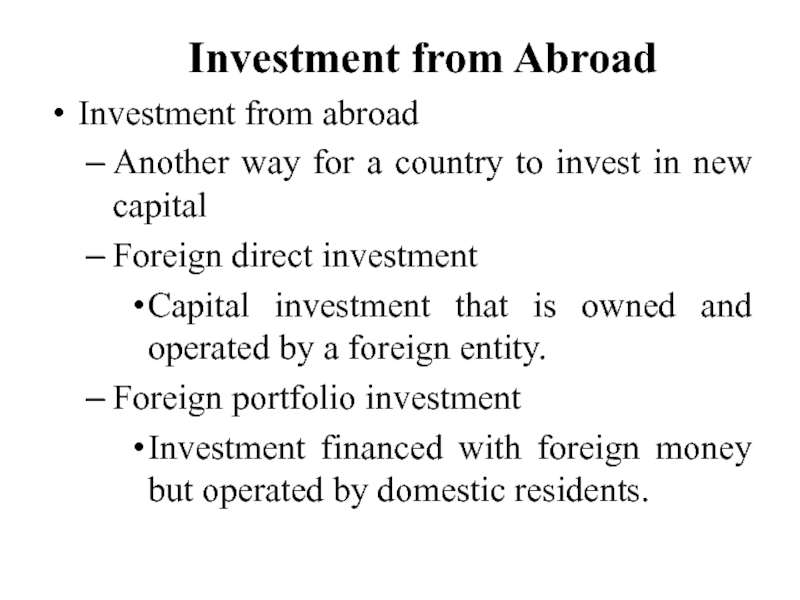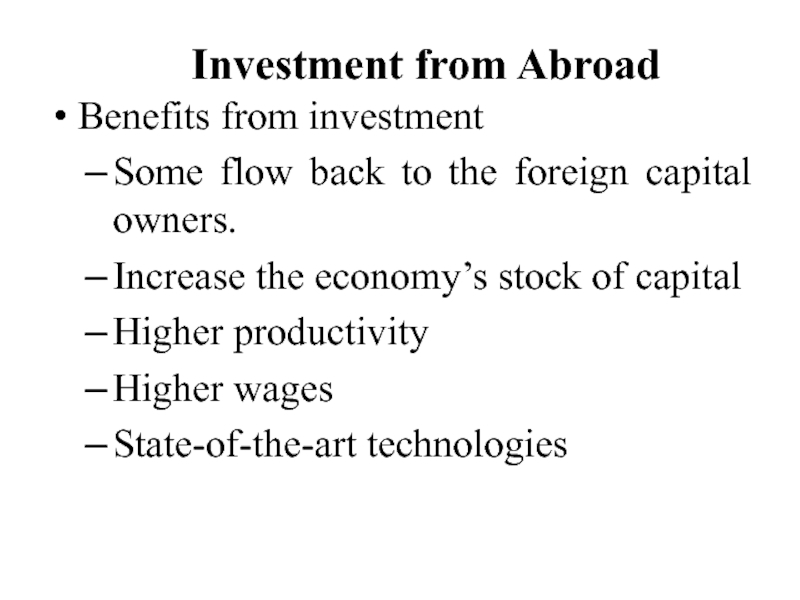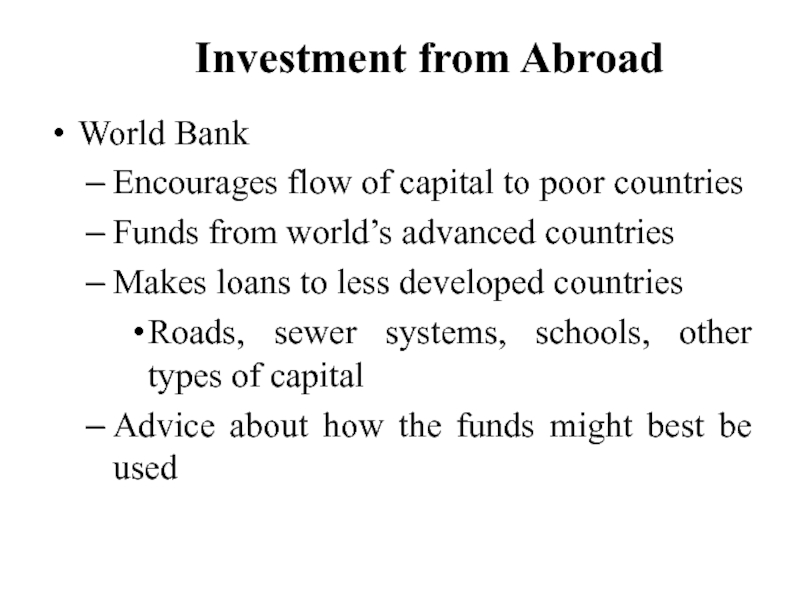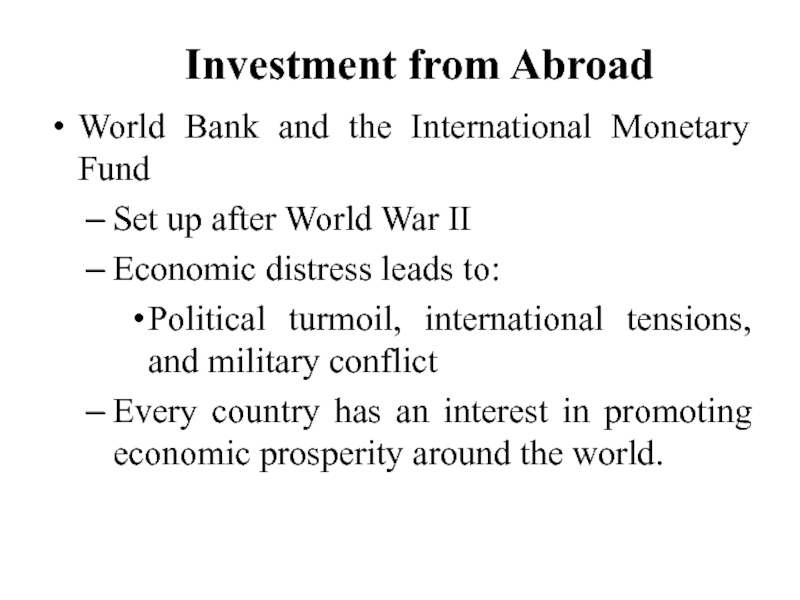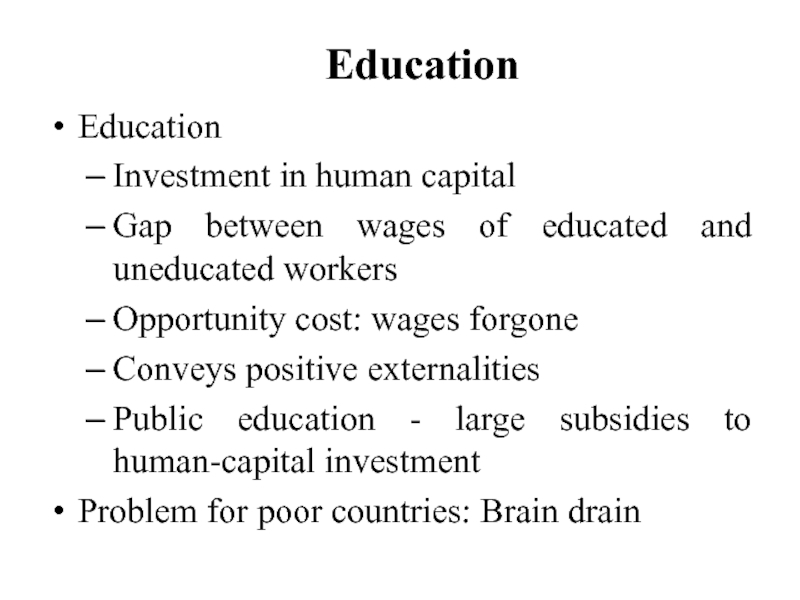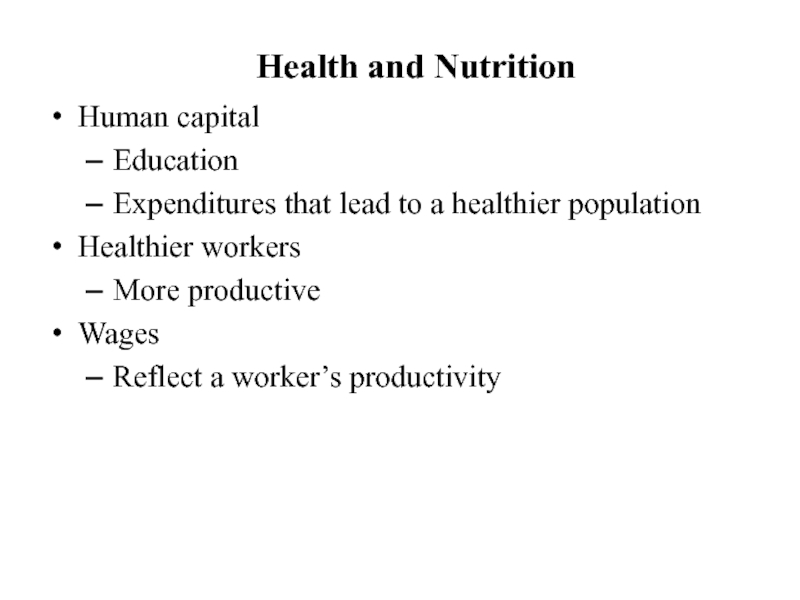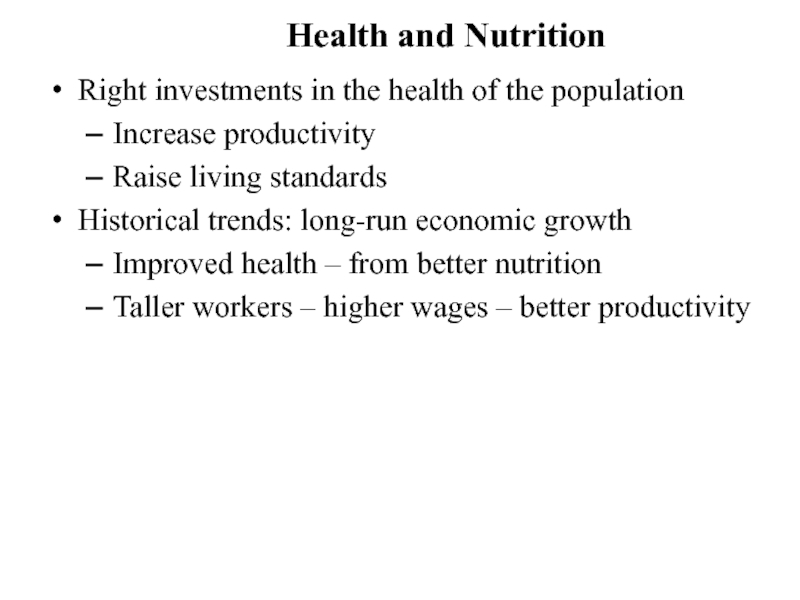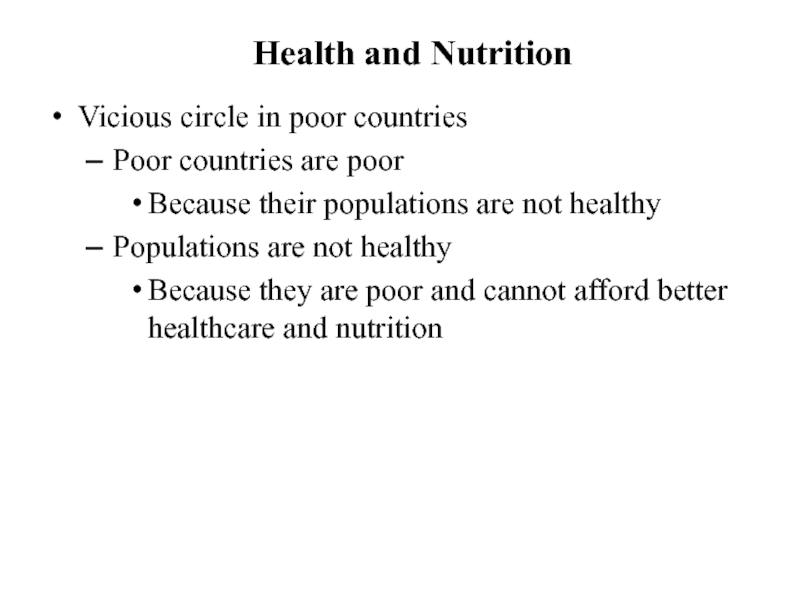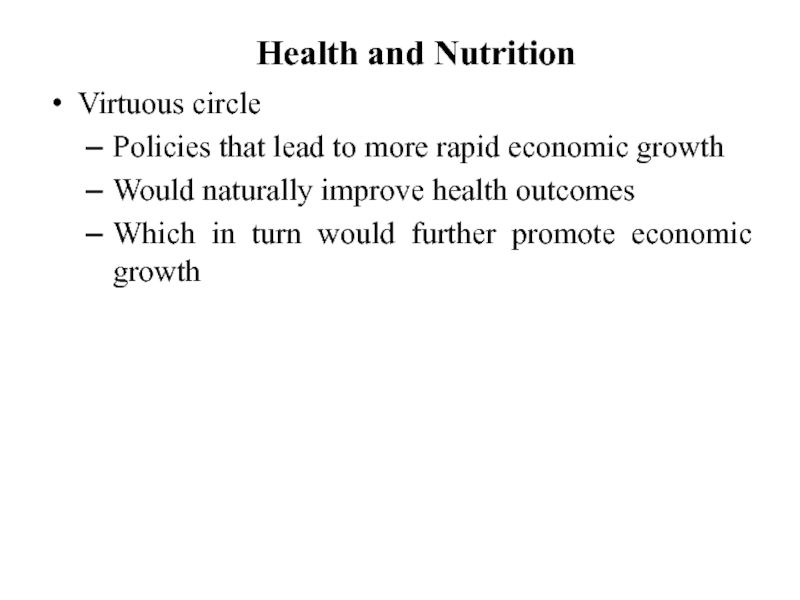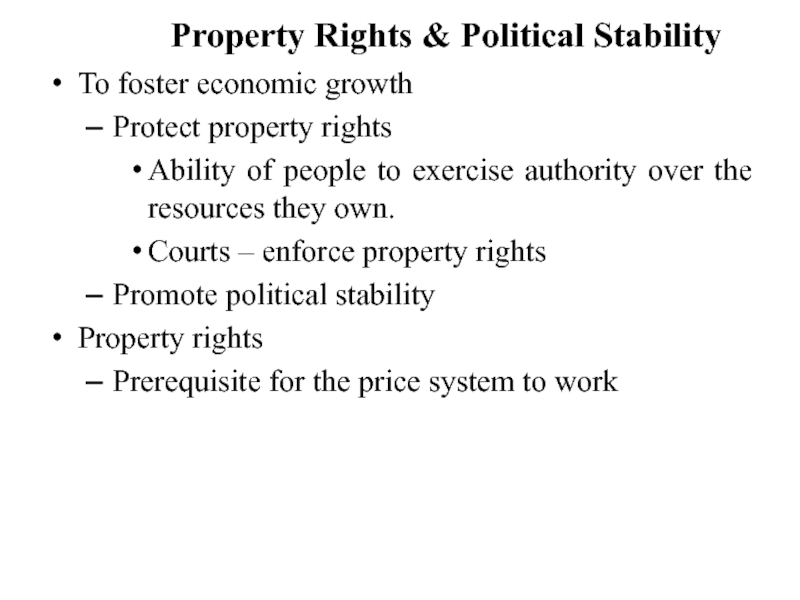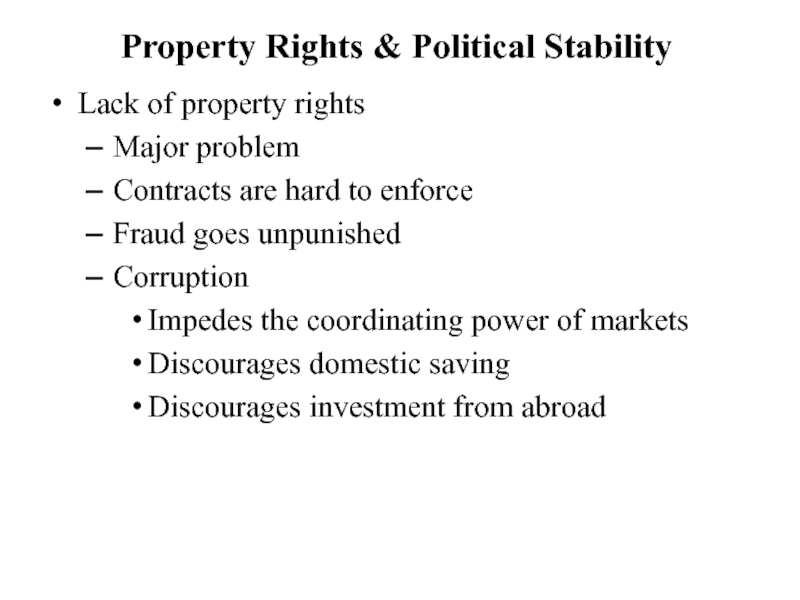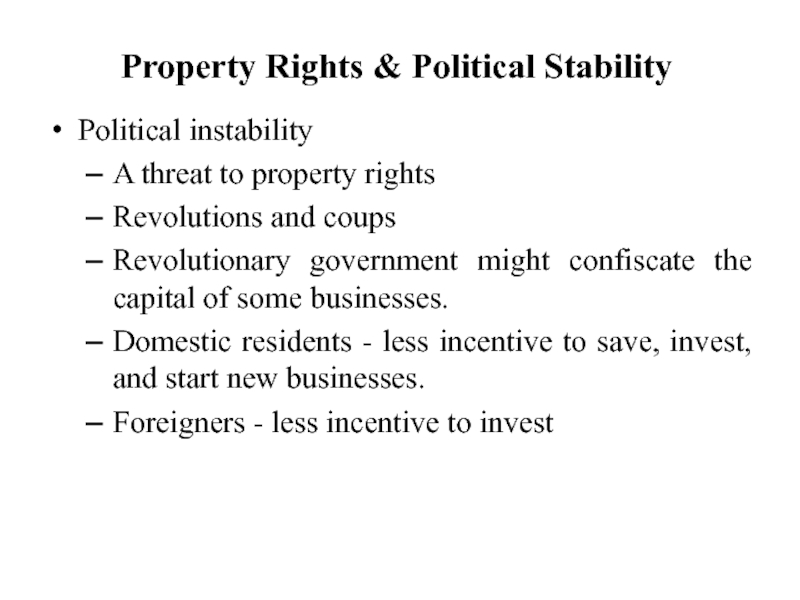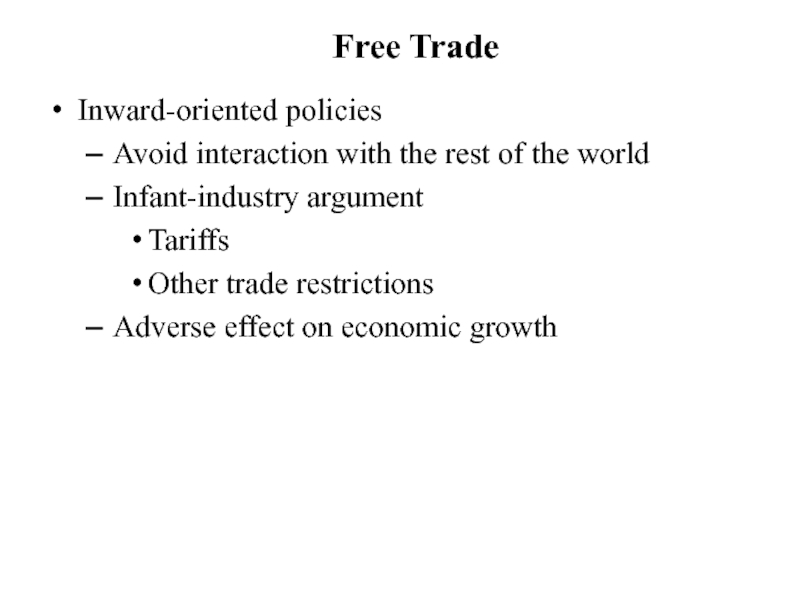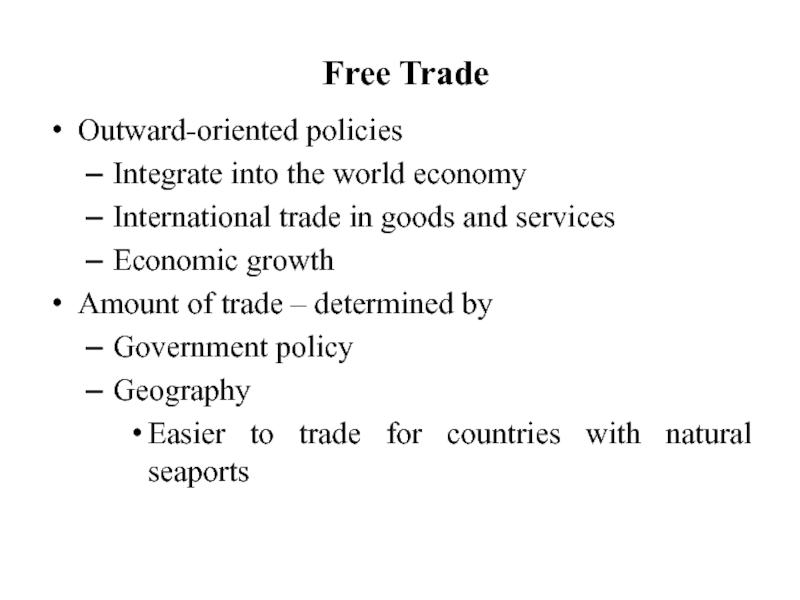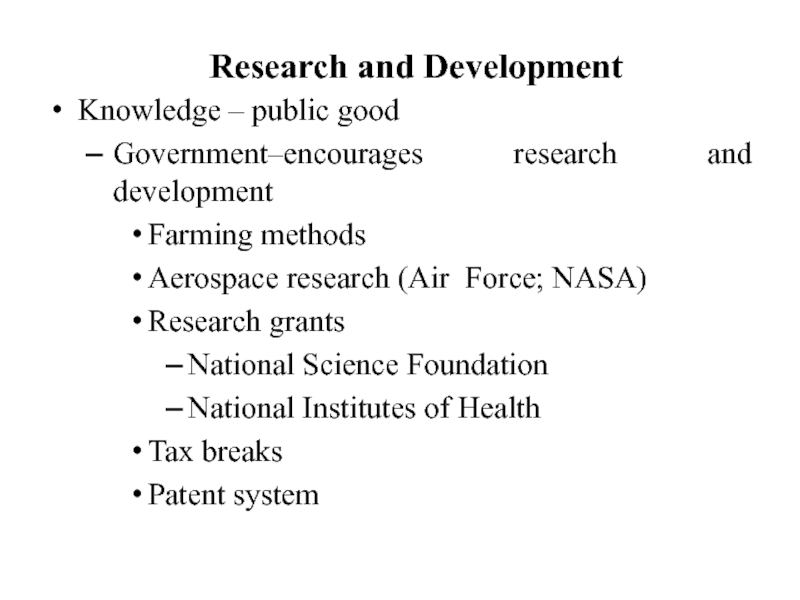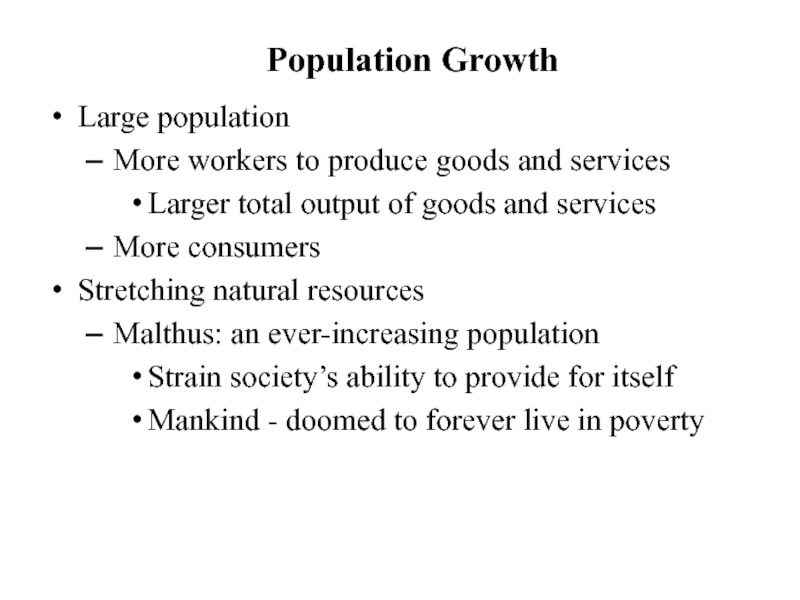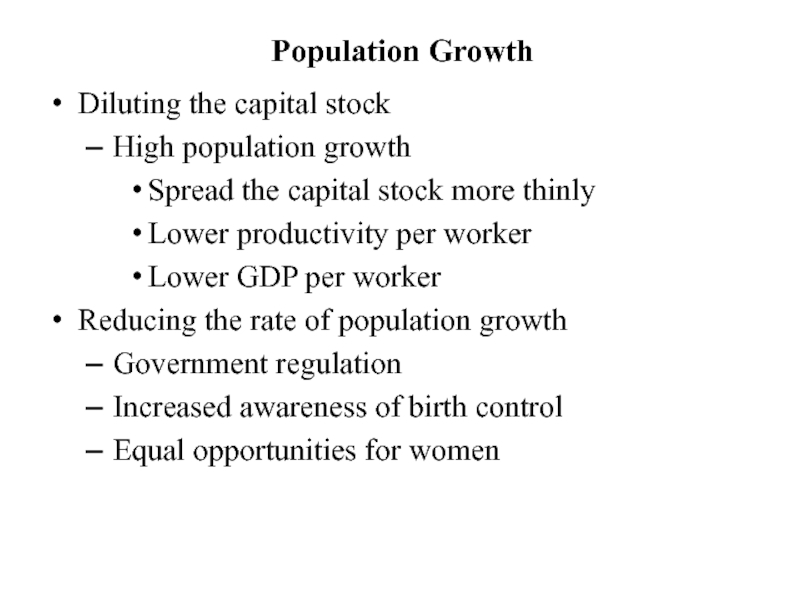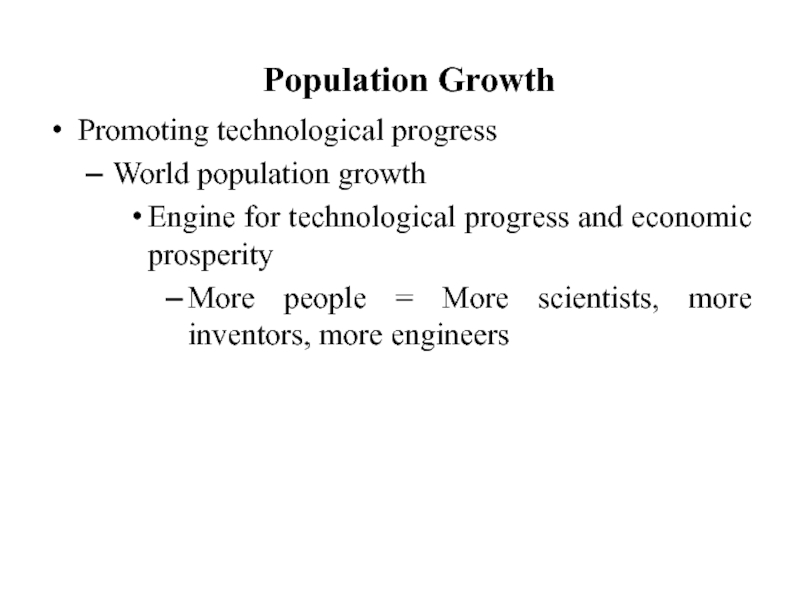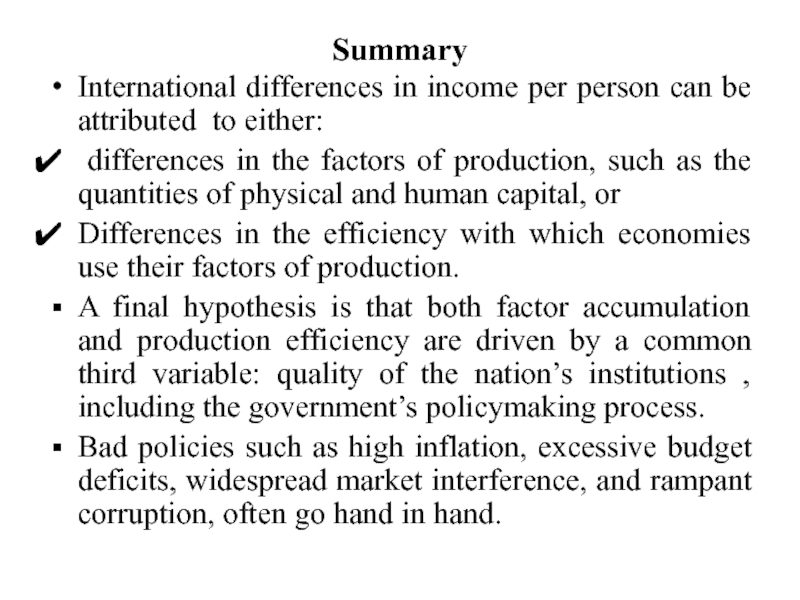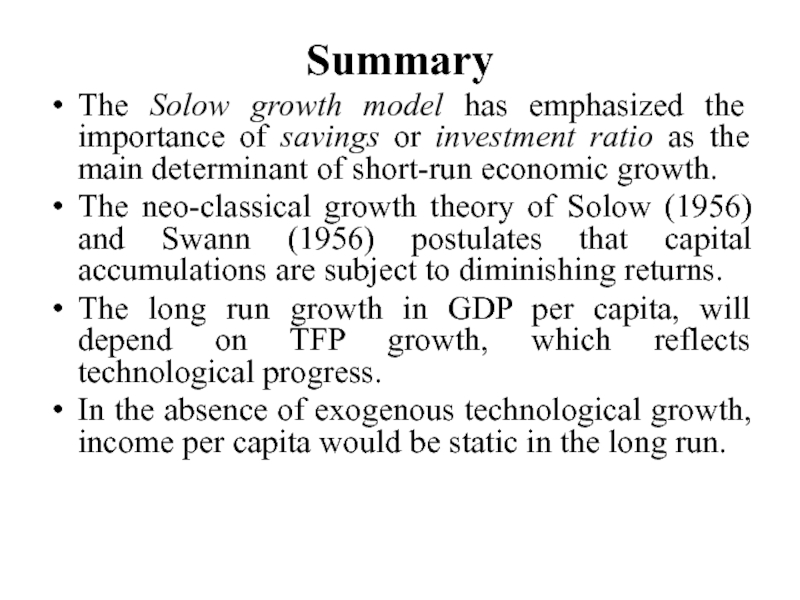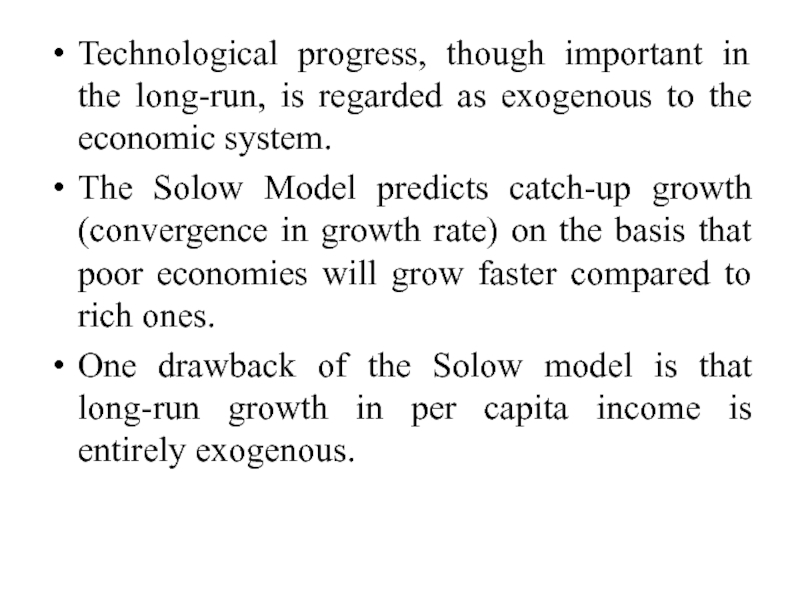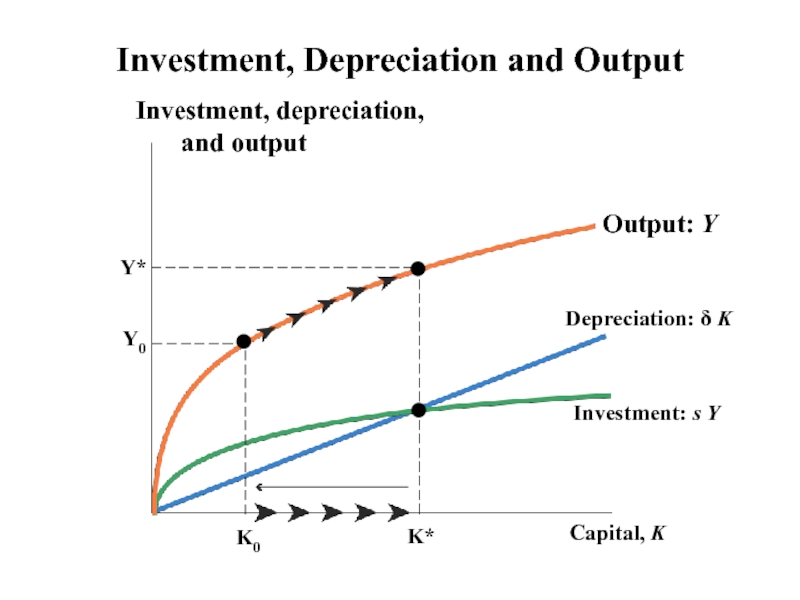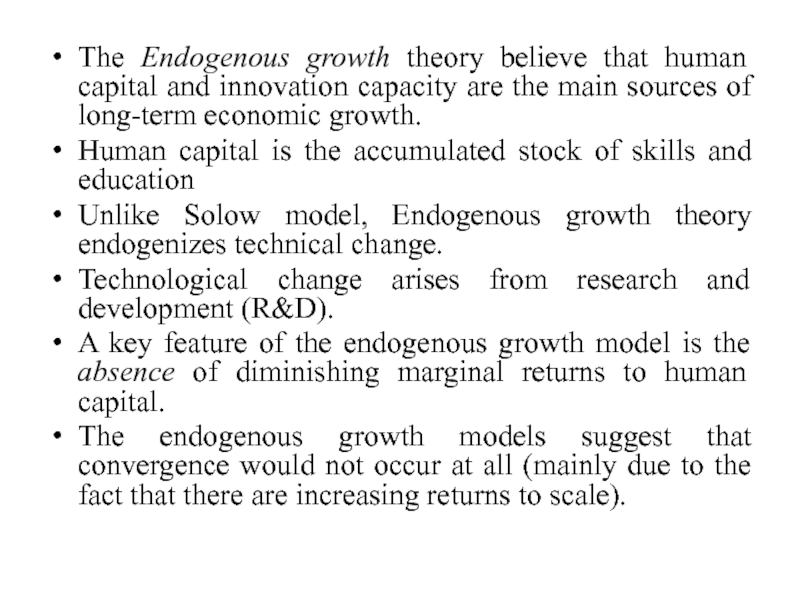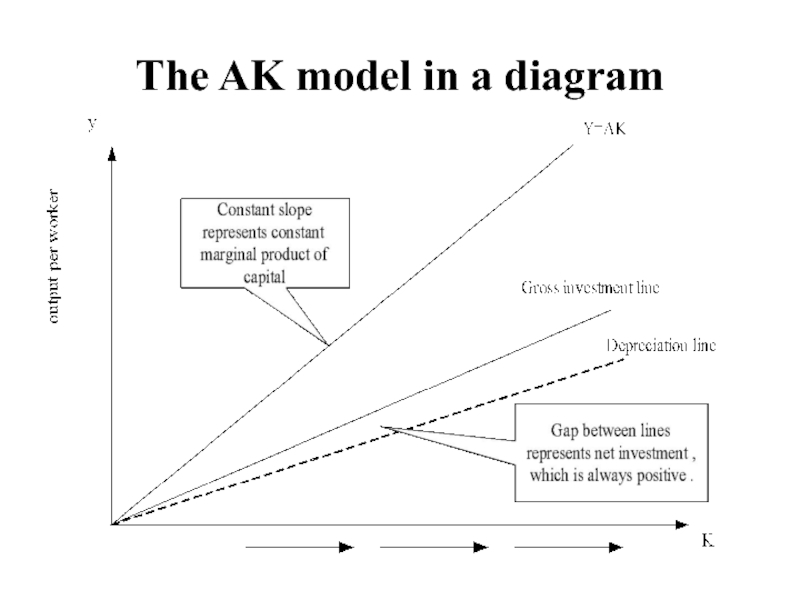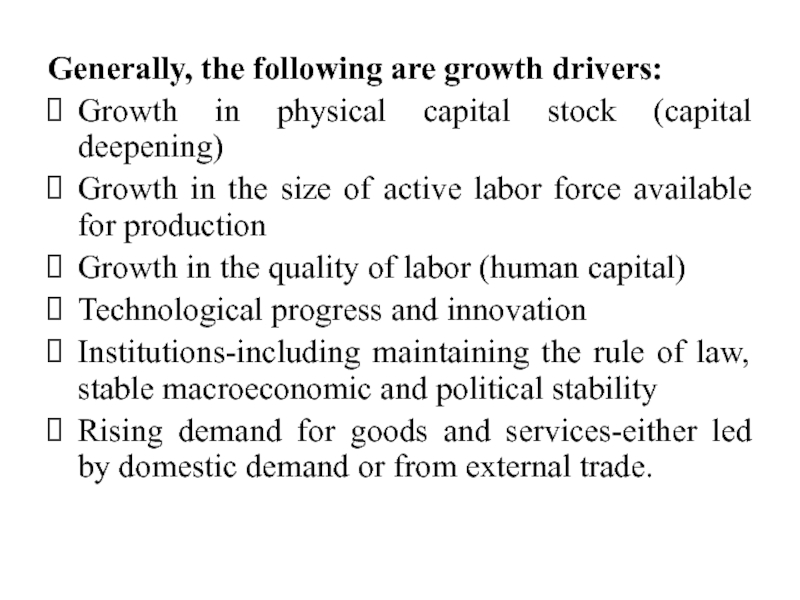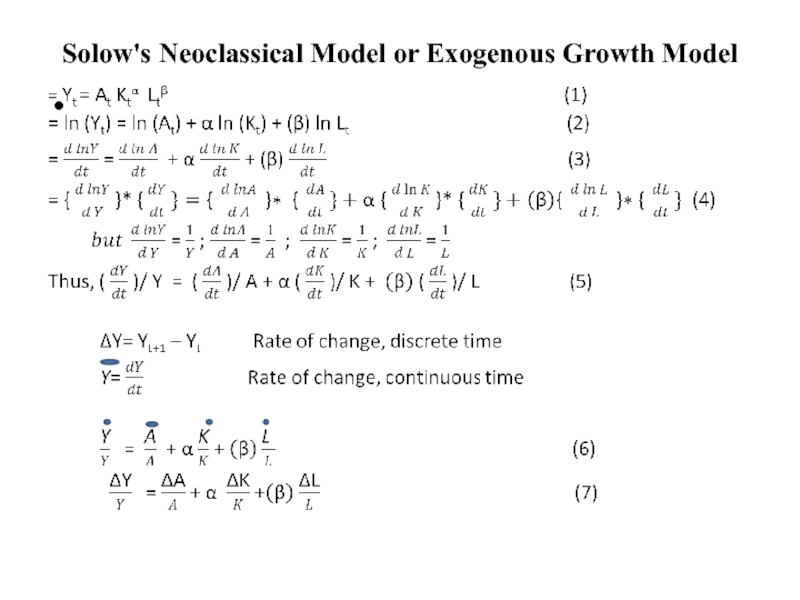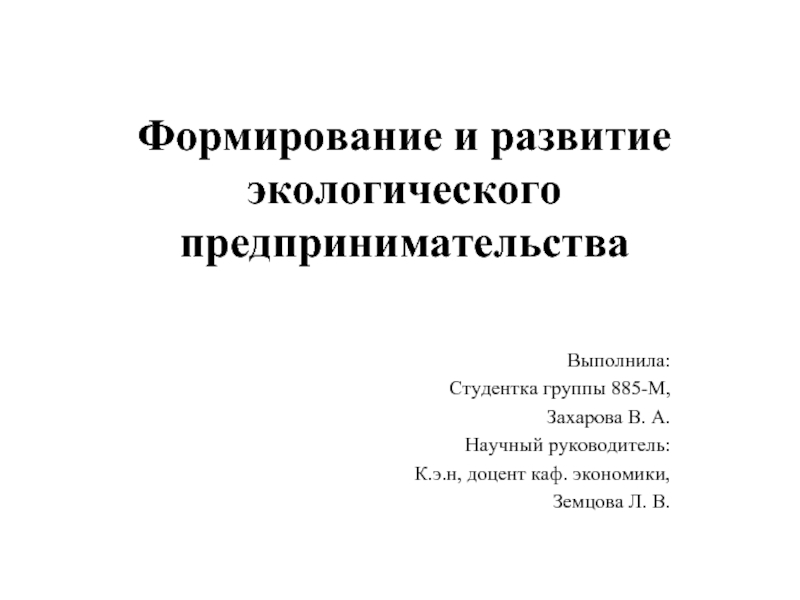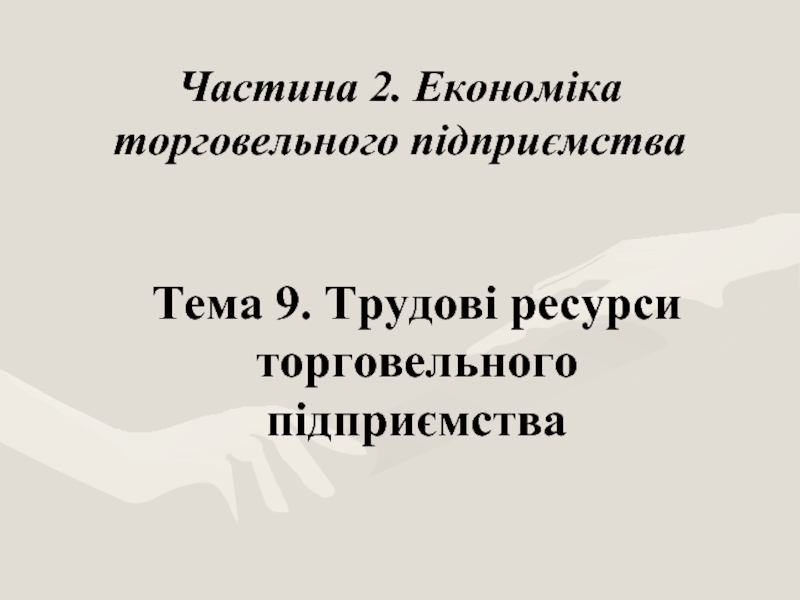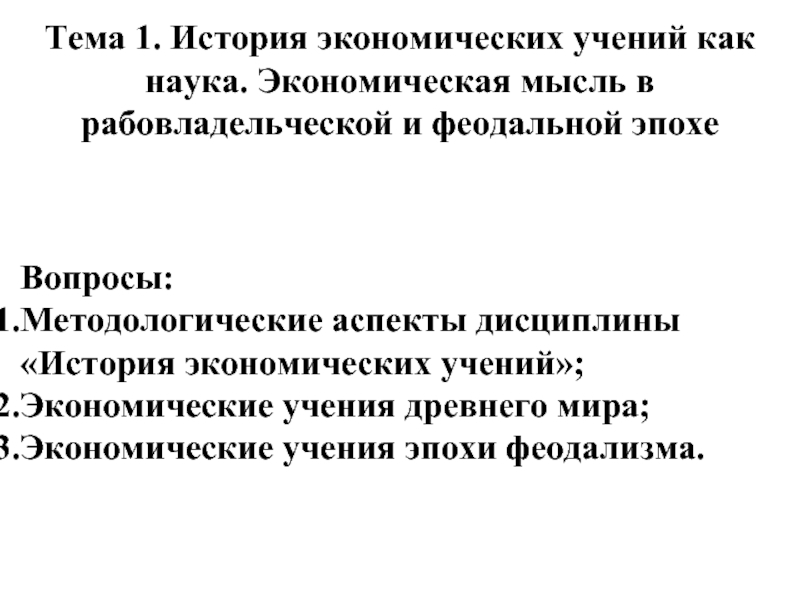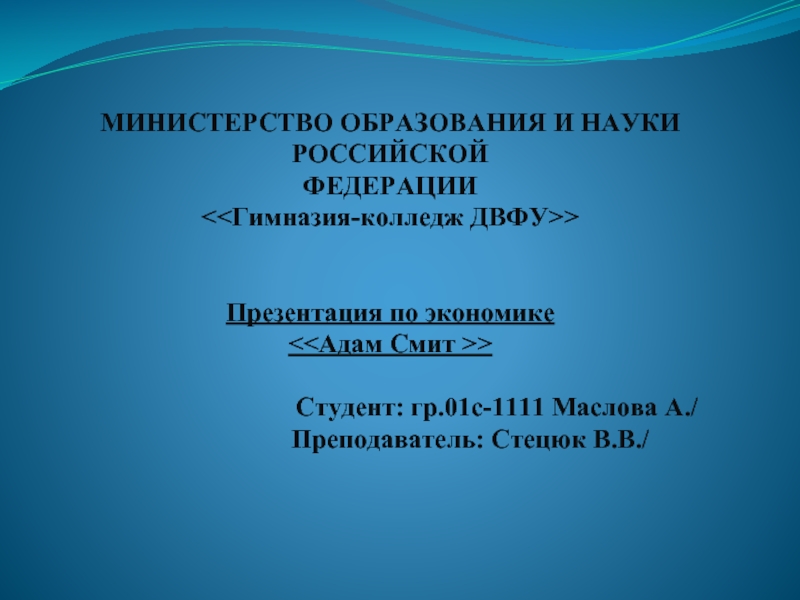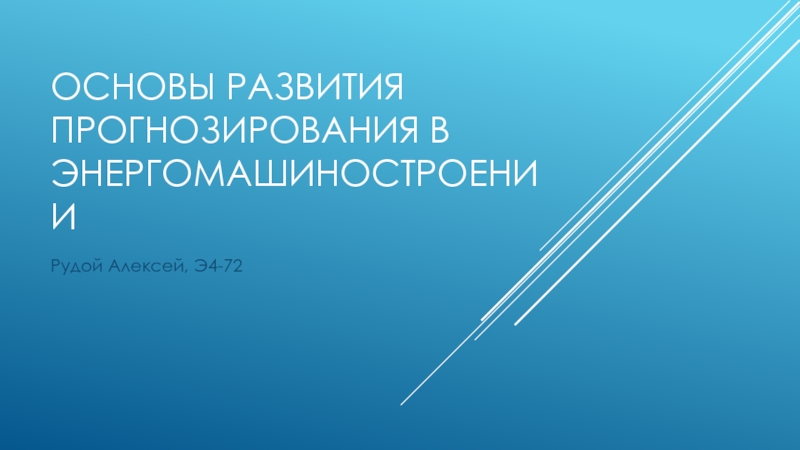others so poor?
Why do growth rates vary across countries and over time?
What are the policies that can change growth in the short and long run?
Why do some countries ``take off'' while others fall behind?
- Главная
- Разное
- Дизайн
- Бизнес и предпринимательство
- Аналитика
- Образование
- Развлечения
- Красота и здоровье
- Финансы
- Государство
- Путешествия
- Спорт
- Недвижимость
- Армия
- Графика
- Культурология
- Еда и кулинария
- Лингвистика
- Английский язык
- Астрономия
- Алгебра
- Биология
- География
- Детские презентации
- Информатика
- История
- Литература
- Маркетинг
- Математика
- Медицина
- Менеджмент
- Музыка
- МХК
- Немецкий язык
- ОБЖ
- Обществознание
- Окружающий мир
- Педагогика
- Русский язык
- Технология
- Физика
- Философия
- Химия
- Шаблоны, картинки для презентаций
- Экология
- Экономика
- Юриспруденция
Production and growth презентация
Содержание
- 1. Production and growth
- 2. Economic Growth Economic growth is
- 3. Rostow’s Five-Stage Model of Development Rostow's Stages
- 4. Rostow’s Five-Stage Model of Development
- 5. Modernization Theory Linear stages of development
- 6. Economic Growth Growth rate How rapidly real
- 7. The Variety of Growth Experiences
- 8. Productivity Productivity Quantity of goods and services
- 9. Productivity Determinants of productivity Physical capital
- 10. Productivity Determinants of productivity Natural resources
- 11. Additionally, other explanations have highlighted the significant
- 12. Solow's Neoclassical Model or Exogenous Growth Model
- 13. This can be transformed into a linear
- 14. The slope coefficients can be interpreted as
- 16. Neoclassical Production Functions The Cobb-Douglas production function
- 17. GDP per worker and k Assume A
- 18. Diminishing Returns The neo-classical growth theory of
- 19. Illustrating the Production Function
- 20. Diminishing Returns If the variable factor of
- 21. Catch-up effect (Convergence) Countries that start
- 22. A second approach explains convergence as resulting
- 23. World’s ten fastest-growing economies
- 24. What causes the differences in income
- 25. Investment refers to the expenditure on new
- 26. Depreciation is the amount of capital that
- 27. Depreciation: δ K Investment: s f (k) Investment, Depreciation, and the Steady state
- 28. The steady-state level of capital K* is
- 29. The major accomplishment of the Solow model
- 30. Investment, Depreciation and Output Output: Y Depreciation: δ K Investment: s Y
- 31. Solving Mathematically for the Steady State In
- 32. Understanding Differences in Growth Rates OECD countries
- 33. Some Things to Notice The farther the
- 36. Investment in South Korea and the Philippines, 1950-2000
- 37. Brazil, S. Korea, Philippines Source: Penn World Table 6.1 (http://pwt.econ.upenn.edu/aboutpwt.html)
- 38. Application: Do Economies Converge? Unconditional (Absolute)
- 39. Imagine that at the end of their
- 40. According to the traditional neoclassical growth theory:
- 41. Endogenous Growth Theory The neo-classical growth theory
- 42. Endogenous growth states that long-run economic growth
- 43. To introduce endogenous growth, it is necessary
- 44. The largest difference between these two economic
- 45. Correlation between Educational Attainment and Growth Rate in Real GDP per Worker
- 46. The AK model The ‘AK model’ is
- 47. The AK model in a diagram
- 48. Endogenous Technology Growth (by Ken Arrow (1962)
- 49. Assuming A=g(K) is Ken Arrow’s (1962) learning-by-doing
- 50. No Convergence Neoclassical growth theory predicts:
- 51. Consumption and Output Paths of the Rich and Poor Countries
- 52. Convergence Robert Barro tested these competing theories,
- 53. Transformation of the Korean Economy (1945-2005)
- 54. Policy Choice and Quality of Institutions Matter: The Korean Experiment Source: Aye M. Alemu (2015)
- 55. Flying geese’ pattern of economic development in
- 56. Japan succeeded first in modernizing its economy
- 57. Structural Transformation in East Asia
- 58. Are natural resources a limit to growth?
- 59. Are natural resources a limit to growth?
- 60. Are natural resources a limit to growth?
- 61. Saving and Investment Raise future productivity Invest
- 62. Higher savings rate Fewer resources – used
- 63. Investment from Abroad Investment from abroad Another
- 64. Investment from Abroad Benefits from investment Some
- 65. Investment from Abroad World Bank Encourages flow
- 66. Investment from Abroad World Bank and the
- 67. Education Education Investment in human
- 68. Health and Nutrition Human capital Education Expenditures
- 69. Health and Nutrition Right investments in the
- 70. Health and Nutrition Vicious circle in poor
- 71. Health and Nutrition Virtuous circle Policies that
- 72. Property Rights & Political Stability To foster
- 73. Property Rights & Political Stability Lack of
- 74. Property Rights & Political Stability Political instability
- 75. Free Trade Inward-oriented policies Avoid interaction with
- 76. Free Trade Outward-oriented policies Integrate into the
- 77. Research and Development Knowledge – public good
- 78. Population Growth Large population More workers to
- 79. Population Growth Diluting the capital stock High
- 80. Population Growth Promoting technological progress World population
- 81. Summary International differences in income per person
- 82. Summary The Solow growth model has emphasized
- 83. Technological progress, though important in the long-run,
- 84. Investment, Depreciation and Output Output: Y Depreciation: δ K Investment: s Y
- 85. The Endogenous growth theory believe that human
- 86. The AK model in a diagram
- 87. Generally, the following are growth drivers: Growth
- 88. Solow's Neoclassical Model or Exogenous Growth Model
Слайд 2
Economic Growth
Economic growth is a long-term expansion of the productive potential
of the economy.
Growth is not the same as development! Growth can support development but the two are distinct.
M. Todaro defines economic development as an increase in living standards, improvement in self-esteem needs and freedom from oppression as well as a greater choice.
Economic development is Concerned with structural changes in the economy, but economic growth is concerned only with increase in the economy’s output.
Economic growth is a necessary but not sufficient condition of economic development.
Economic growth brings quantitative changes in the economy; where as economic development deals with quantitative and qualitative changes in the economy.
Growth is not the same as development! Growth can support development but the two are distinct.
M. Todaro defines economic development as an increase in living standards, improvement in self-esteem needs and freedom from oppression as well as a greater choice.
Economic development is Concerned with structural changes in the economy, but economic growth is concerned only with increase in the economy’s output.
Economic growth is a necessary but not sufficient condition of economic development.
Economic growth brings quantitative changes in the economy; where as economic development deals with quantitative and qualitative changes in the economy.
Слайд 3Rostow’s Five-Stage Model of Development
Rostow's Stages of Growth model is one
of the most influential development theories of the twentieth century. In 1960, Rostow presented five steps through which all countries must pass to become developed.
Traditional Society: This stage is characterized by a subsistent, agricultural based economy, with intensive labor and low levels of trading, and a population that does not have a scientific perspective on the world and technology.
Preconditions to Take-off: In this stage, the rates of investment are getting higher and a society begins to develop manufacturing.
Take-off: Rostow describes this stage as a short period of intensive growth, in which industrialization begins to occur, and workers and institutions become concentrated around a new industry.
Drive to Maturity: This stage takes place over a long period of time, as standards of living rise, use of technology increases, and the national economy grows and diversifies.
Age of High Mass Consumption: Here, a country's economy flourishes in a capitalist system, characterized by mass production and consumerism.
Traditional Society: This stage is characterized by a subsistent, agricultural based economy, with intensive labor and low levels of trading, and a population that does not have a scientific perspective on the world and technology.
Preconditions to Take-off: In this stage, the rates of investment are getting higher and a society begins to develop manufacturing.
Take-off: Rostow describes this stage as a short period of intensive growth, in which industrialization begins to occur, and workers and institutions become concentrated around a new industry.
Drive to Maturity: This stage takes place over a long period of time, as standards of living rise, use of technology increases, and the national economy grows and diversifies.
Age of High Mass Consumption: Here, a country's economy flourishes in a capitalist system, characterized by mass production and consumerism.
Слайд 6Economic Growth
Growth rate
How rapidly real GDP per person grew in the
typical year.
Growth in GDP per capita (or per worker) Y/L
Real GDP per person
Living standard
Vary widely from country to country
Because of differences in growth rates
Ranking of countries by income changes substantially over time
Growth in GDP per capita (or per worker) Y/L
Real GDP per person
Living standard
Vary widely from country to country
Because of differences in growth rates
Ranking of countries by income changes substantially over time
Слайд 8Productivity
Productivity
Quantity of goods and services
Produced from each unit of labor input
Why
productivity is so important
Key determinant of living standards
Growth in productivity is the key determinant of growth in living standards
An economy’s income is the economy’s output
Key determinant of living standards
Growth in productivity is the key determinant of growth in living standards
An economy’s income is the economy’s output
Слайд 9Productivity
Determinants of productivity
Physical capital
Stock of equipment and structures
Used to produce
goods and services
Human capital
Knowledge and skills that workers acquire through education, training, and experience
Human capital
Knowledge and skills that workers acquire through education, training, and experience
Слайд 10Productivity
Determinants of productivity
Natural resources
Inputs into the production of goods and
services
Provided by nature, such as land, rivers, and mineral deposits
Technological knowledge
Society’s understanding of the best ways to produce goods and services
Provided by nature, such as land, rivers, and mineral deposits
Technological knowledge
Society’s understanding of the best ways to produce goods and services
Слайд 11Additionally, other explanations have highlighted the significant role of non-economic factors.
These
include institutional economics which underlines the substantial role of institutions, policy, legal and political systems (Matthews, 1986; North, 1990; Jutting, 2003)
Economic sociology stressed the importance of socio-cultural factors such as Confucianism in East Asia (Granovetter, 1985; Knack and Keefer, 1997).
Economic sociology stressed the importance of socio-cultural factors such as Confucianism in East Asia (Granovetter, 1985; Knack and Keefer, 1997).
Слайд 12Solow's Neoclassical Model or Exogenous Growth Model
The Sources of Economic Growth
Production
function
Y= AF(K, L) (1)
The Cobb-Douglas Production Function:
Y= A Kα Lβ (2)
Where, A stands for TFP that represents the portion of output not caused by traditionally measured inputs such as capital and labor.
The terms α and β are the elasticities of output with respect to capital and labor, respectively.
Y= AF(K, L) (1)
The Cobb-Douglas Production Function:
Y= A Kα Lβ (2)
Where, A stands for TFP that represents the portion of output not caused by traditionally measured inputs such as capital and labor.
The terms α and β are the elasticities of output with respect to capital and labor, respectively.
Слайд 13This can be transformed into a linear model by taking natural
logs of both sides:
ln Y= ln A + α ln K + β ln L (3)
Decompose into growth rate form: the growth accounting equation:
ΔY/Y=ΔA/A + α ΔK/K+ βΔL/L (4)
ΔY/Y= Growth in Output
α (ΔK/K) = Contribution of Capital
(1- α) ΔL/L = Contribution of Labor
ΔA/A = Growth in Total Factor Productivity (TFP)
Growth in TFP represents output growth not accounted for by the growth in inputs.
ln Y= ln A + α ln K + β ln L (3)
Decompose into growth rate form: the growth accounting equation:
ΔY/Y=ΔA/A + α ΔK/K+ βΔL/L (4)
ΔY/Y= Growth in Output
α (ΔK/K) = Contribution of Capital
(1- α) ΔL/L = Contribution of Labor
ΔA/A = Growth in Total Factor Productivity (TFP)
Growth in TFP represents output growth not accounted for by the growth in inputs.
Слайд 14The slope coefficients can be interpreted as elasticities.
If (α + β)
= 1, we have constant returns to scale.
If (α + β) > 1, we have increasing returns to scale.
If (α + β) < 1, we have decreasing returns to scale.
Both α and β are less than 1 due to diminishing marginal productivity
Interpretation
A rise of 10 % in A raises output by 10%.
A rise of 10% in K raises output by α times 10%.
A rise of 10% in L raises output by β times 10%.
For instance; in Unites States, real GDP has grown an average of 3.6 percent per year since 1950.
Of this 3.6 percent, 1.2 percent is attributable to increases in the capital stock, 1.3 percent to increases in the labor input, and 1.1 percent to increases in TFP.
If (α + β) > 1, we have increasing returns to scale.
If (α + β) < 1, we have decreasing returns to scale.
Both α and β are less than 1 due to diminishing marginal productivity
Interpretation
A rise of 10 % in A raises output by 10%.
A rise of 10% in K raises output by α times 10%.
A rise of 10% in L raises output by β times 10%.
For instance; in Unites States, real GDP has grown an average of 3.6 percent per year since 1950.
Of this 3.6 percent, 1.2 percent is attributable to increases in the capital stock, 1.3 percent to increases in the labor input, and 1.1 percent to increases in TFP.
Слайд 16Neoclassical Production Functions
The Cobb-Douglas production function is expressed as:
Hence, now have
y = output (GDP) per worker as function of capital to labour ratio (k)
Слайд 18Diminishing Returns
The neo-classical growth theory of Solow (1956) and Swan (1956)
postulates that capital accumulations are subject to diminishing marginal returns to capital.
Diminishing returns implies that the amount of extra output from each additional unit of input goes down as the quantity of input increases.
Saving and investment are beneficial in the short-run, but diminishing returns to capital do not sustain long-run growth.
In other words, after we reach the steady state, there is no long-run growth in Yt (unless Lt or A increases).
Diminishing returns implies that the amount of extra output from each additional unit of input goes down as the quantity of input increases.
Saving and investment are beneficial in the short-run, but diminishing returns to capital do not sustain long-run growth.
In other words, after we reach the steady state, there is no long-run growth in Yt (unless Lt or A increases).
Слайд 19
Illustrating the Production Function
This figure shows how the amount of
capital per worker influences the amount of output per worker. Other determinants of output, including human capital, natural resources, and technology, are held constant. The curve becomes flatter as the amount of capital increases because of diminishing returns to capital.
Слайд 20Diminishing Returns
If the variable factor of production increases, the output will
increase up to a certain point.
After a certain point, that factor becomes less productive; therefore, there will eventually be a decreasing marginal return and average product decreases.
Rich countries
High productivity
Additional capital investment leads to a small effect on productivity
Poor countries tend to grow faster than rich countries.
Even small amounts of capital investment may increase workers’ productivity substantially.
After a certain point, that factor becomes less productive; therefore, there will eventually be a decreasing marginal return and average product decreases.
Rich countries
High productivity
Additional capital investment leads to a small effect on productivity
Poor countries tend to grow faster than rich countries.
Even small amounts of capital investment may increase workers’ productivity substantially.
Слайд 21Catch-up effect (Convergence)
Countries that start off poor tend to grow more
rapidly than countries that start off rich.
Poor countries have the potential to grow at a faster rate than rich countries because diminishing returns are not as strong as in capital-rich countries.
Furthermore, poorer countries can replicate the production methods, technologies, and institutions of developed countries.
The neoclassical approach pioneered by Solow (1956) and subsequently developed by Barrow and Sala-i-Martin (1991, 1995) and Mankiw et al (1992). explains convergence is a result of decreasing returns in physical capital accumulation.
Poor countries have the potential to grow at a faster rate than rich countries because diminishing returns are not as strong as in capital-rich countries.
Furthermore, poorer countries can replicate the production methods, technologies, and institutions of developed countries.
The neoclassical approach pioneered by Solow (1956) and subsequently developed by Barrow and Sala-i-Martin (1991, 1995) and Mankiw et al (1992). explains convergence is a result of decreasing returns in physical capital accumulation.
Слайд 22A second approach explains convergence as resulting primarily from cross- country
knowledge spillovers.
The process of diffusion, or technology spillover from another country is an important factor behind cross-country convergence.
However, the fact that a country is poor does not guarantee that catch-up growth will be achieved.
The ability of a country to catch-up depends on its ability to absorb new technology, attract capital and participate in global markets, and that is why there is still divergence in the world today.
The process of diffusion, or technology spillover from another country is an important factor behind cross-country convergence.
However, the fact that a country is poor does not guarantee that catch-up growth will be achieved.
The ability of a country to catch-up depends on its ability to absorb new technology, attract capital and participate in global markets, and that is why there is still divergence in the world today.
Слайд 24
What causes the differences in income over time and across countries?
The
Solow growth model shows how saving, population growth, and technological progress affect the level of an economy’s output and its growth over time.
Labor grows exogenously through population growth.
Capital is accumulated as a result of savings behavior.
The capital stock is a key determinant of the economy’s output.
But, the capital stock can change over time, and those changes can lead to economic growth.
In particular, two forces influence the capital stock: investment and depreciation.
Labor grows exogenously through population growth.
Capital is accumulated as a result of savings behavior.
The capital stock is a key determinant of the economy’s output.
But, the capital stock can change over time, and those changes can lead to economic growth.
In particular, two forces influence the capital stock: investment and depreciation.
Слайд 25Investment refers to the expenditure on new plant and equipment, and
it causes the capital stock to rise.
Depreciation refers to the wearing out of old capital, and it causes the capital stock to fall.
The saving rate ‘s’ determines the allocation of output between consumption and investment. For any level of k, output is f(k), investment is s f(k), and consumption is
f(k) – sf(k).
On the other hand, investment per worker (i) can be expressed as a function of the capital stock per worker: i= sf(k)
This equation relates the existing stock of capital ‘k’ to the accumulation of new capital ‘i’.
The capital stock next year equals the sum of the capital started with this year plus the amount of investment undertaken this year minus depreciation.
Depreciation refers to the wearing out of old capital, and it causes the capital stock to fall.
The saving rate ‘s’ determines the allocation of output between consumption and investment. For any level of k, output is f(k), investment is s f(k), and consumption is
f(k) – sf(k).
On the other hand, investment per worker (i) can be expressed as a function of the capital stock per worker: i= sf(k)
This equation relates the existing stock of capital ‘k’ to the accumulation of new capital ‘i’.
The capital stock next year equals the sum of the capital started with this year plus the amount of investment undertaken this year minus depreciation.
Слайд 26Depreciation is the amount of capital that wears out each period
~ 10 percent/year.
kt+1 =kt +It – δ kt
Change in capital stock= investment-Depreciation
Δk = I- δk
Where Δk is the change in the capital stock between one year and the next.
Because investment I equals sf (k), we can write this as:
Δk = sf(k)- δk
The higher the capital stock, the greater the amounts of output and investment.
Yet the higher the capital stock, the greater also the amount of depreciation.
kt+1 =kt +It – δ kt
Change in capital stock= investment-Depreciation
Δk = I- δk
Where Δk is the change in the capital stock between one year and the next.
Because investment I equals sf (k), we can write this as:
Δk = sf(k)- δk
The higher the capital stock, the greater the amounts of output and investment.
Yet the higher the capital stock, the greater also the amount of depreciation.
Слайд 28The steady-state level of capital K* is the level at which
investment equals depreciation, indicating that the amount of capital will not change over time.
Below K* is the level at which investment exceeds depreciation, so the capital stock grows.
Above K*, investment is less than depreciation, so the capital stock shrinks.
In this sense, the steady state represents the long-run equilibrium of the economy.
Below K* is the level at which investment exceeds depreciation, so the capital stock grows.
Above K*, investment is less than depreciation, so the capital stock shrinks.
In this sense, the steady state represents the long-run equilibrium of the economy.
Слайд 29The major accomplishment of the Solow model is the principle of
transition dynamics, which states that the farther below its steady state an economy is, the faster it will grow.
Increases in the investment rate or TFP can increase a country’s steady-state position and therefore increase growth, at least for a number of years.
However, it does not explain why different countries have different investment and productivity rates.
In general, most poor countries have low TFP levels and low investment rates, the two key determinants of steady-state incomes.
Increases in the investment rate or TFP can increase a country’s steady-state position and therefore increase growth, at least for a number of years.
However, it does not explain why different countries have different investment and productivity rates.
In general, most poor countries have low TFP levels and low investment rates, the two key determinants of steady-state incomes.
Слайд 31Solving Mathematically for the Steady State
In the steady state, investment equals
depreciation and we can solve mathematically for it.
In the steady state: Δk = sf(k)- δk=0
= sf(k) = δk
= sAKαL1-α = δk
= sAL1-α = δK/Kα = δ K1-α
= K1-α = (s AL(1- α))/ δ
= K*= L (s A/ δ) (1/1- α)
In the Solow model, diminishing returns to capital eventually force the economy to approach a steady state in which growth depends only on exogenous technological progress.
In the steady state: Δk = sf(k)- δk=0
= sf(k) = δk
= sAKαL1-α = δk
= sAL1-α = δK/Kα = δ K1-α
= K1-α = (s AL(1- α))/ δ
= K*= L (s A/ δ) (1/1- α)
In the Solow model, diminishing returns to capital eventually force the economy to approach a steady state in which growth depends only on exogenous technological progress.
Слайд 32Understanding Differences in Growth Rates
OECD countries that were relatively poor in
1960 grew quickly while countries that were relatively rich grew slower.
Solow’s principle of transition dynamics states that the farther below its steady state an economy is, the faster it will grow.
Most poor countries have low TFP levels, low investment rates, and high population growth which are the three key determinants of steady-state incomes.
Countries have more capital because they save a greater part of their income.
Solow’s principle of transition dynamics states that the farther below its steady state an economy is, the faster it will grow.
Most poor countries have low TFP levels, low investment rates, and high population growth which are the three key determinants of steady-state incomes.
Countries have more capital because they save a greater part of their income.
Слайд 33Some Things to Notice
The farther the economy starts below the steady
state level of capital, the faster the economy initially grows.
Mankiw refers to this as the “catch-up” effect.
This is due to the effect of “diminishing returns”
The amount of extra output from each additional unit of capital goes down as the capital stock gets larger.
If a country is able to increase its productivity, capital will “catch up” quite quickly
Growth slows over time until the capital stock reaches the steady state level.
The Solow model shows that the saving rate is a key determinant of the steady-state capital stock.
However, the rate of saving raises growth only until the economy reaches the new steady state.
Mankiw refers to this as the “catch-up” effect.
This is due to the effect of “diminishing returns”
The amount of extra output from each additional unit of capital goes down as the capital stock gets larger.
If a country is able to increase its productivity, capital will “catch up” quite quickly
Growth slows over time until the capital stock reaches the steady state level.
The Solow model shows that the saving rate is a key determinant of the steady-state capital stock.
However, the rate of saving raises growth only until the economy reaches the new steady state.
Слайд 37Brazil, S. Korea, Philippines
Source: Penn World Table 6.1 (http://pwt.econ.upenn.edu/aboutpwt.html)
Слайд 38Application: Do Economies Converge?
Unconditional (Absolute) convergence (α-Convergence) occurs when poor
countries will eventually catch up with the rich countries resulting in similar living standards.
Conditional convergence (β-Convergence):-It will occur, conditional on a number of factors. In other words, it occurs when countries with similar characteristics will converge (savings rate, investment rate, population growth).
No convergence occurs when poor countries do not catch up over time and living standards may diverge.
Conditional convergence (β-Convergence):-It will occur, conditional on a number of factors. In other words, it occurs when countries with similar characteristics will converge (savings rate, investment rate, population growth).
No convergence occurs when poor countries do not catch up over time and living standards may diverge.
Слайд 39Imagine that at the end of their first year, some students
have A averages, whereas others have C averages. Would you expect the A and C students to converge over the remaining three years of college?
The answer depends on why their first-year grades differed. If the differences arose because some students came from better high schools than others, then you might expect those who were initially disadvantaged to start catching up to their better-prepared peers.
But if the differences arose because some students study more than others, you might expect the differences in grades to persist.
Similarly, if two economies have different steady states, perhaps because the economies have different rates of saving, then we should not expect convergence.
The answer depends on why their first-year grades differed. If the differences arose because some students came from better high schools than others, then you might expect those who were initially disadvantaged to start catching up to their better-prepared peers.
But if the differences arose because some students study more than others, you might expect the differences in grades to persist.
Similarly, if two economies have different steady states, perhaps because the economies have different rates of saving, then we should not expect convergence.
Слайд 40According to the traditional neoclassical growth theory:
Output growth results either
from increases in labor, increases in capital, and technological changes.
Closed economies with low savings rates grow slowly in the SR and converge to lower per capita income levels.
Open economies converge at higher levels of per capita income levels.
Traditional neoclassical theory argues that capital flows from rich to poor countries as K-L ratios are lower and investment returns are higher in the latter.
However, in practice, capital flows from rich to rich/poor to rich countries and this is known as the “Lucas paradox.” Why?
Closed economies with low savings rates grow slowly in the SR and converge to lower per capita income levels.
Open economies converge at higher levels of per capita income levels.
Traditional neoclassical theory argues that capital flows from rich to poor countries as K-L ratios are lower and investment returns are higher in the latter.
However, in practice, capital flows from rich to rich/poor to rich countries and this is known as the “Lucas paradox.” Why?
Слайд 41Endogenous Growth Theory
The neo-classical growth theory of Solow (1956) and Swan
(1956) postulates that capital accumulations are subject to diminishing marginal returns to capital.
Endogenous growth theory (Romer, Lucas) emphasizes different growth opportunities in physical capital and knowledge.
Endogenous growth theory predicts diminishing marginal returns to physical capital, but perhaps not knowledge
The long run growth in GDP per capita in Solow model will depend on TFP growth, which reflects technological progress (which is exogenous in the Solow model).
Technology is exogenous implies that it is not determined within the model (it is exogenous)
Endogenous growth theory (Romer, Lucas) emphasizes different growth opportunities in physical capital and knowledge.
Endogenous growth theory predicts diminishing marginal returns to physical capital, but perhaps not knowledge
The long run growth in GDP per capita in Solow model will depend on TFP growth, which reflects technological progress (which is exogenous in the Solow model).
Technology is exogenous implies that it is not determined within the model (it is exogenous)
Слайд 42Endogenous growth states that long-run economic growth is determined by forces
that are internal to the economic system, particularly those forces governing the opportunities and incentives to create technological knowledge.
Endogenous growth theory states technological change arises in large part because of intentional actions taken by people
Endogenous growth theory endogenizes technical change, including human capital, and other forms of knowledge-rich capital in capital stocks.
One drawback of the Solow model is that long-run growth in per capita income is entirely exogenous.
In the absence of exogenous technological growth, income per capita would be static in the long run. This is an implication of diminishing marginal returns to capital.
Endogenous growth theory states technological change arises in large part because of intentional actions taken by people
Endogenous growth theory endogenizes technical change, including human capital, and other forms of knowledge-rich capital in capital stocks.
One drawback of the Solow model is that long-run growth in per capita income is entirely exogenous.
In the absence of exogenous technological growth, income per capita would be static in the long run. This is an implication of diminishing marginal returns to capital.
Слайд 43To introduce endogenous growth, it is necessary to have increasing (or
at least non-decreasing) returns to capital.
As in the Solow model, technological change fuels growth.
Technological change arises from research and development (R&D).
Endogenous growth theory rejects the Solow model’s assumption of exogenous technological change.
Advocates of endogenous growth theory argue that the assumption of constant (rather than diminishing) returns to capital is more palatable if ‘K’ is interpreted more broadly; i.e., to view knowledge as a type of capital.
Human capital is the accumulated stock of skills and education
As in the Solow model, technological change fuels growth.
Technological change arises from research and development (R&D).
Endogenous growth theory rejects the Solow model’s assumption of exogenous technological change.
Advocates of endogenous growth theory argue that the assumption of constant (rather than diminishing) returns to capital is more palatable if ‘K’ is interpreted more broadly; i.e., to view knowledge as a type of capital.
Human capital is the accumulated stock of skills and education
Слайд 44The largest difference between these two economic growth models is that
the endogenous growth theory argues that economies do not reach stability, as economies achieve constant returns to capital.
Endogenous growth theory asserts that the rate of economic growth is dependent on whether the country invests in technological or human capital.
In the early 1970s, the rate of growth fell in most industrialized countries. The cause of this slowdown is not well understood.
In the mid-1990s, the rate of growth increased, most likely because of advances in information technology.
A key feature of the endogenous growth model is the absence of diminishing marginal returns to human capital.
This absence of diminishing marginal returns leads to unbounded growth in output per worker.
Endogenous growth theory predicts diminishing marginal returns to physical capital, but perhaps not knowledge.
Endogenous growth theory asserts that the rate of economic growth is dependent on whether the country invests in technological or human capital.
In the early 1970s, the rate of growth fell in most industrialized countries. The cause of this slowdown is not well understood.
In the mid-1990s, the rate of growth increased, most likely because of advances in information technology.
A key feature of the endogenous growth model is the absence of diminishing marginal returns to human capital.
This absence of diminishing marginal returns leads to unbounded growth in output per worker.
Endogenous growth theory predicts diminishing marginal returns to physical capital, but perhaps not knowledge.
Слайд 46The AK model
The ‘AK model’ is sometimes termed an ‘endogenous growth
model’
The model has Y = AK
where K can be thought of as some composite ‘capital and labour’ input
Clearly this has constant marginal product of capital (MPk = dY/dK=A), hence long run growth is possible
Thus, the ‘AK model’ is a simple way of illustrating endogenous growth concept
However, it is very simple! ‘A’ is poorly defined, yet critical to growth rate
Also composite ‘K’ is unappealing
The model has Y = AK
where K can be thought of as some composite ‘capital and labour’ input
Clearly this has constant marginal product of capital (MPk = dY/dK=A), hence long run growth is possible
Thus, the ‘AK model’ is a simple way of illustrating endogenous growth concept
However, it is very simple! ‘A’ is poorly defined, yet critical to growth rate
Also composite ‘K’ is unappealing
Слайд 48Endogenous Technology Growth (by Ken Arrow (1962)
Suppose that technology depends
on past investment (i.e. the process of investment generates new ideas, knowledge and learning).
If α+β = 1 then Y= KL(1-α) and marginal product of capital is constant (dY/dK = L1-α ).
Слайд 49Assuming A=g(K) is Ken Arrow’s (1962) learning-by-doing paper
The intuition is that
learning about technology prevents marginal product declining.
Слайд 50No Convergence
Neoclassical growth theory predicts:
Conditional convergence for economies with equal
rates of saving and population growth and with access to the same technology.
Un-conditional (absolute) convergence for economies with different rates of savings and/or population growth → steady state level of income differ, but growth rates eventually converge
In the endogenous growth model, two identical countries that differ only in their initial incomes will never converge.
Un-conditional (absolute) convergence for economies with different rates of savings and/or population growth → steady state level of income differ, but growth rates eventually converge
In the endogenous growth model, two identical countries that differ only in their initial incomes will never converge.
Слайд 52Convergence
Robert Barro tested these competing theories, and found that:
Countries with higher
levels of investment tend to grow faster.
The impact of higher investment on growth is however transitory.
Countries with higher investment end in a steady state with higher per capita income, but not with a higher growth rate.
Countries do appear to converge conditionally, and thus endogenous growth theory is not very useful for explaining international differences in growth rates.
The impact of higher investment on growth is however transitory.
Countries with higher investment end in a steady state with higher per capita income, but not with a higher growth rate.
Countries do appear to converge conditionally, and thus endogenous growth theory is not very useful for explaining international differences in growth rates.
Слайд 54Policy Choice and Quality of Institutions Matter: The Korean Experiment
Source: Aye
M. Alemu (2015)
Слайд 55Flying geese’ pattern of economic development in East Asia
The phrase “flying
geese pattern of development” was coined originally by Kaname Akamatsu in the 1930s and it resembles like a wild-geese flying pattern.
The FG pattern of industrial development is transmitted from a lead goose (Japan) to follower geese (NIEs, ASEAN 4, China, etc.).
Wild-geese flying pattern
The FG pattern of industrial development is transmitted from a lead goose (Japan) to follower geese (NIEs, ASEAN 4, China, etc.).
Wild-geese flying pattern
Слайд 56Japan succeeded first in modernizing its economy during the latter half
of the 19th century. Despite the interruption of World War II, it became virtually the sole developed country in Asia in the 1960s.
The second wave of industrialization in East Asia took place in the Asian NIEs known as the four ‘dragons’ or ‘tigers’ (Taiwan, Korea, Hong Kong and Singapore) from the 1950s to the 1970s.
The third wave of industrialization occurred in the leading ASEAN countries (Malaysia, Thailand, the Philippines and Indonesia) in the 1980s.
The fourth wave of industrialization in the 1990s was led by China, which had industrialized itself by the 1980s, when its opening up to the world economy by Deng Xiaoping.
Vietnam, one of the newcomer ASEAN countries, followed suit and successfully reformed its economy through ‘Doi Moi’ (renovation)
Currently, the wave of industrialization in East Asia has reached Lao PDR and Cambodia.
The second wave of industrialization in East Asia took place in the Asian NIEs known as the four ‘dragons’ or ‘tigers’ (Taiwan, Korea, Hong Kong and Singapore) from the 1950s to the 1970s.
The third wave of industrialization occurred in the leading ASEAN countries (Malaysia, Thailand, the Philippines and Indonesia) in the 1980s.
The fourth wave of industrialization in the 1990s was led by China, which had industrialized itself by the 1980s, when its opening up to the world economy by Deng Xiaoping.
Vietnam, one of the newcomer ASEAN countries, followed suit and successfully reformed its economy through ‘Doi Moi’ (renovation)
Currently, the wave of industrialization in East Asia has reached Lao PDR and Cambodia.
Слайд 58Are natural resources a limit to growth?
Argument
Natural resources - will eventually
limit how much the world’s economies can grow
Fixed supply of nonrenewable natural resources – will run out.
Stop economic growth
Force living standards to fall
Fixed supply of nonrenewable natural resources – will run out.
Stop economic growth
Force living standards to fall
Слайд 59Are natural resources a limit to growth?
Technological progress
Often yields ways to
avoid these limits
Improved use of natural resources over time
Recycling
New materials
Are these efforts enough to permit continued economic growth?
Improved use of natural resources over time
Recycling
New materials
Are these efforts enough to permit continued economic growth?
Слайд 60Are natural resources a limit to growth?
Prices of natural resources
Scarcity -
reflected in market prices
Natural resource prices
Substantial short-run fluctuations
Stable or falling - over long spans of time
It depends on our ability to conserve these resources.
Natural resource prices
Substantial short-run fluctuations
Stable or falling - over long spans of time
It depends on our ability to conserve these resources.
Слайд 61Saving and Investment
Raise future productivity
Invest more current resources in the production
of capital.
Trade-off
Devote fewer resources to produce goods and services for current consumption.
Trade-off
Devote fewer resources to produce goods and services for current consumption.
Слайд 62Higher savings rate
Fewer resources – used to make consumption goods
More resources
– to make capital goods
Capital stock increases
Rising productivity
More rapid growth in GDP
Capital stock increases
Rising productivity
More rapid growth in GDP
Слайд 63Investment from Abroad
Investment from abroad
Another way for a country to invest
in new capital
Foreign direct investment
Capital investment that is owned and operated by a foreign entity.
Foreign portfolio investment
Investment financed with foreign money but operated by domestic residents.
Foreign direct investment
Capital investment that is owned and operated by a foreign entity.
Foreign portfolio investment
Investment financed with foreign money but operated by domestic residents.
Слайд 64Investment from Abroad
Benefits from investment
Some flow back to the foreign capital
owners.
Increase the economy’s stock of capital
Higher productivity
Higher wages
State-of-the-art technologies
Increase the economy’s stock of capital
Higher productivity
Higher wages
State-of-the-art technologies
Слайд 65Investment from Abroad
World Bank
Encourages flow of capital to poor countries
Funds from
world’s advanced countries
Makes loans to less developed countries
Roads, sewer systems, schools, other types of capital
Advice about how the funds might best be used
Makes loans to less developed countries
Roads, sewer systems, schools, other types of capital
Advice about how the funds might best be used
Слайд 66Investment from Abroad
World Bank and the International Monetary Fund
Set up after
World War II
Economic distress leads to:
Political turmoil, international tensions, and military conflict
Every country has an interest in promoting economic prosperity around the world.
Economic distress leads to:
Political turmoil, international tensions, and military conflict
Every country has an interest in promoting economic prosperity around the world.
Слайд 67Education
Education
Investment in human capital
Gap between wages of educated and
uneducated workers
Opportunity cost: wages forgone
Conveys positive externalities
Public education - large subsidies to human-capital investment
Problem for poor countries: Brain drain
Opportunity cost: wages forgone
Conveys positive externalities
Public education - large subsidies to human-capital investment
Problem for poor countries: Brain drain
Слайд 68Health and Nutrition
Human capital
Education
Expenditures that lead to a healthier population
Healthier workers
More
productive
Wages
Reflect a worker’s productivity
Wages
Reflect a worker’s productivity
Слайд 69Health and Nutrition
Right investments in the health of the population
Increase productivity
Raise
living standards
Historical trends: long-run economic growth
Improved health – from better nutrition
Taller workers – higher wages – better productivity
Historical trends: long-run economic growth
Improved health – from better nutrition
Taller workers – higher wages – better productivity
Слайд 70Health and Nutrition
Vicious circle in poor countries
Poor countries are poor
Because their
populations are not healthy
Populations are not healthy
Because they are poor and cannot afford better healthcare and nutrition
Populations are not healthy
Because they are poor and cannot afford better healthcare and nutrition
Слайд 71Health and Nutrition
Virtuous circle
Policies that lead to more rapid economic growth
Would naturally improve health outcomes
Which in turn would further promote economic growth
Слайд 72Property Rights & Political Stability
To foster economic growth
Protect property rights
Ability of
people to exercise authority over the resources they own.
Courts – enforce property rights
Promote political stability
Property rights
Prerequisite for the price system to work
Courts – enforce property rights
Promote political stability
Property rights
Prerequisite for the price system to work
Слайд 73Property Rights & Political Stability
Lack of property rights
Major problem
Contracts are hard
to enforce
Fraud goes unpunished
Corruption
Impedes the coordinating power of markets
Discourages domestic saving
Discourages investment from abroad
Fraud goes unpunished
Corruption
Impedes the coordinating power of markets
Discourages domestic saving
Discourages investment from abroad
Слайд 74Property Rights & Political Stability
Political instability
A threat to property rights
Revolutions and
coups
Revolutionary government might confiscate the capital of some businesses.
Domestic residents - less incentive to save, invest, and start new businesses.
Foreigners - less incentive to invest
Revolutionary government might confiscate the capital of some businesses.
Domestic residents - less incentive to save, invest, and start new businesses.
Foreigners - less incentive to invest
Слайд 75Free Trade
Inward-oriented policies
Avoid interaction with the rest of the world
Infant-industry argument
Tariffs
Other
trade restrictions
Adverse effect on economic growth
Adverse effect on economic growth
Слайд 76Free Trade
Outward-oriented policies
Integrate into the world economy
International trade in goods and
services
Economic growth
Amount of trade – determined by
Government policy
Geography
Easier to trade for countries with natural seaports
Economic growth
Amount of trade – determined by
Government policy
Geography
Easier to trade for countries with natural seaports
Слайд 77Research and Development
Knowledge – public good
Government–encourages research and development
Farming methods
Aerospace
research (Air Force; NASA)
Research grants
National Science Foundation
National Institutes of Health
Tax breaks
Patent system
Research grants
National Science Foundation
National Institutes of Health
Tax breaks
Patent system
Слайд 78Population Growth
Large population
More workers to produce goods and services
Larger total output
of goods and services
More consumers
Stretching natural resources
Malthus: an ever-increasing population
Strain society’s ability to provide for itself
Mankind - doomed to forever live in poverty
More consumers
Stretching natural resources
Malthus: an ever-increasing population
Strain society’s ability to provide for itself
Mankind - doomed to forever live in poverty
Слайд 79Population Growth
Diluting the capital stock
High population growth
Spread the capital stock more
thinly
Lower productivity per worker
Lower GDP per worker
Reducing the rate of population growth
Government regulation
Increased awareness of birth control
Equal opportunities for women
Lower productivity per worker
Lower GDP per worker
Reducing the rate of population growth
Government regulation
Increased awareness of birth control
Equal opportunities for women
Слайд 80Population Growth
Promoting technological progress
World population growth
Engine for technological progress and economic
prosperity
More people = More scientists, more inventors, more engineers
More people = More scientists, more inventors, more engineers
Слайд 81Summary
International differences in income per person can be attributed to either:
differences in the factors of production, such as the quantities of physical and human capital, or
Differences in the efficiency with which economies use their factors of production.
A final hypothesis is that both factor accumulation and production efficiency are driven by a common third variable: quality of the nation’s institutions , including the government’s policymaking process.
Bad policies such as high inflation, excessive budget deficits, widespread market interference, and rampant corruption, often go hand in hand.
Differences in the efficiency with which economies use their factors of production.
A final hypothesis is that both factor accumulation and production efficiency are driven by a common third variable: quality of the nation’s institutions , including the government’s policymaking process.
Bad policies such as high inflation, excessive budget deficits, widespread market interference, and rampant corruption, often go hand in hand.
Слайд 82Summary
The Solow growth model has emphasized the importance of savings or
investment ratio as the main determinant of short-run economic growth.
The neo-classical growth theory of Solow (1956) and Swann (1956) postulates that capital accumulations are subject to diminishing returns.
The long run growth in GDP per capita, will depend on TFP growth, which reflects technological progress.
In the absence of exogenous technological growth, income per capita would be static in the long run.
The neo-classical growth theory of Solow (1956) and Swann (1956) postulates that capital accumulations are subject to diminishing returns.
The long run growth in GDP per capita, will depend on TFP growth, which reflects technological progress.
In the absence of exogenous technological growth, income per capita would be static in the long run.
Слайд 83Technological progress, though important in the long-run, is regarded as exogenous
to the economic system.
The Solow Model predicts catch-up growth (convergence in growth rate) on the basis that poor economies will grow faster compared to rich ones.
One drawback of the Solow model is that long-run growth in per capita income is entirely exogenous.
The Solow Model predicts catch-up growth (convergence in growth rate) on the basis that poor economies will grow faster compared to rich ones.
One drawback of the Solow model is that long-run growth in per capita income is entirely exogenous.
Слайд 85The Endogenous growth theory believe that human capital and innovation capacity
are the main sources of long-term economic growth.
Human capital is the accumulated stock of skills and education
Unlike Solow model, Endogenous growth theory endogenizes technical change.
Technological change arises from research and development (R&D).
A key feature of the endogenous growth model is the absence of diminishing marginal returns to human capital.
The endogenous growth models suggest that convergence would not occur at all (mainly due to the fact that there are increasing returns to scale).
Human capital is the accumulated stock of skills and education
Unlike Solow model, Endogenous growth theory endogenizes technical change.
Technological change arises from research and development (R&D).
A key feature of the endogenous growth model is the absence of diminishing marginal returns to human capital.
The endogenous growth models suggest that convergence would not occur at all (mainly due to the fact that there are increasing returns to scale).
Слайд 87Generally, the following are growth drivers:
Growth in physical capital stock (capital
deepening)
Growth in the size of active labor force available for production
Growth in the quality of labor (human capital)
Technological progress and innovation
Institutions-including maintaining the rule of law, stable macroeconomic and political stability
Rising demand for goods and services-either led by domestic demand or from external trade.
Growth in the size of active labor force available for production
Growth in the quality of labor (human capital)
Technological progress and innovation
Institutions-including maintaining the rule of law, stable macroeconomic and political stability
Rising demand for goods and services-either led by domestic demand or from external trade.
